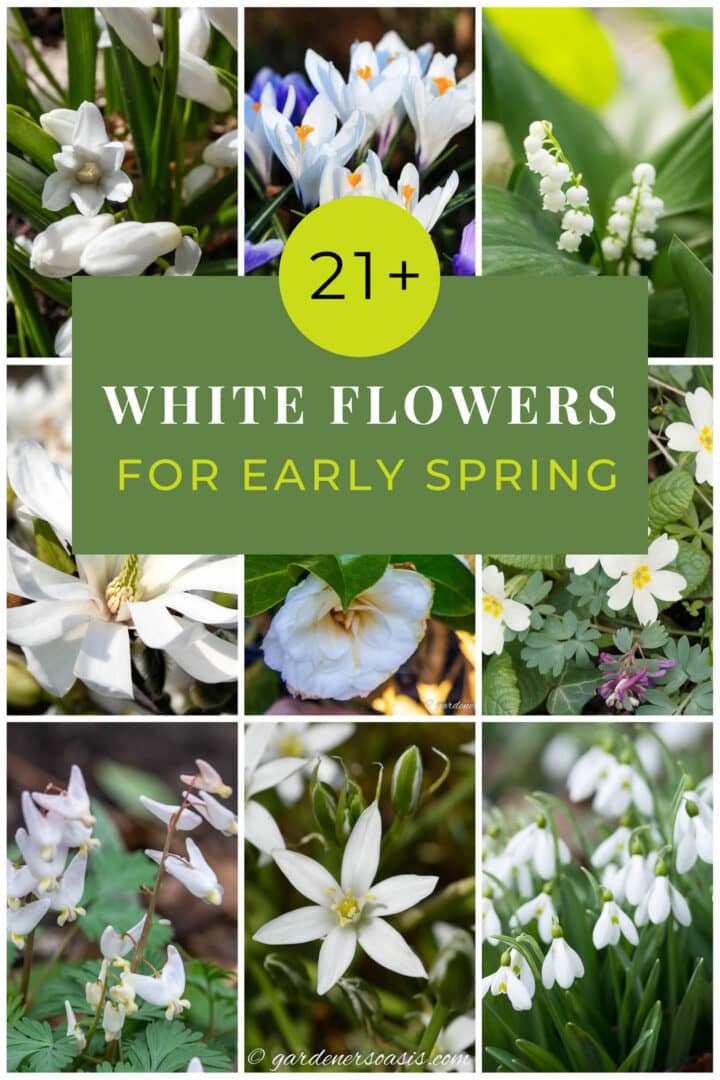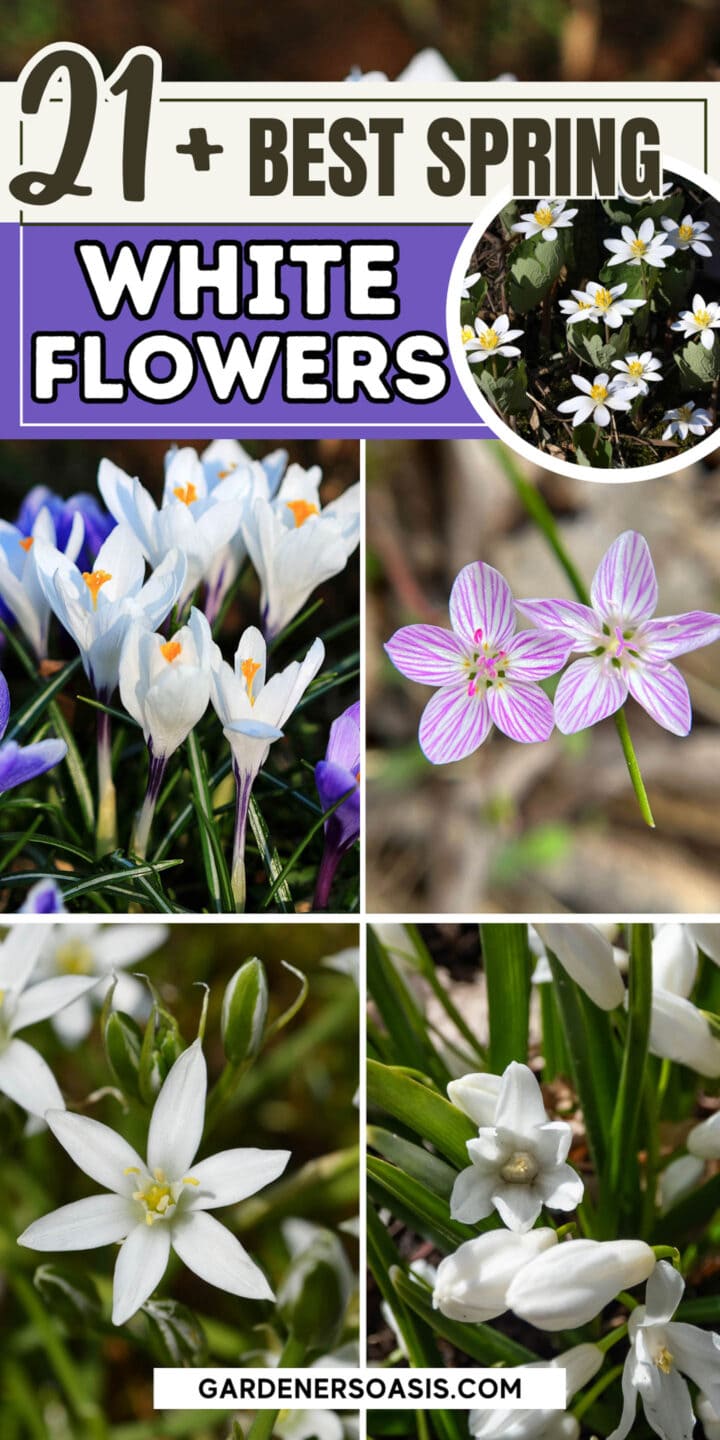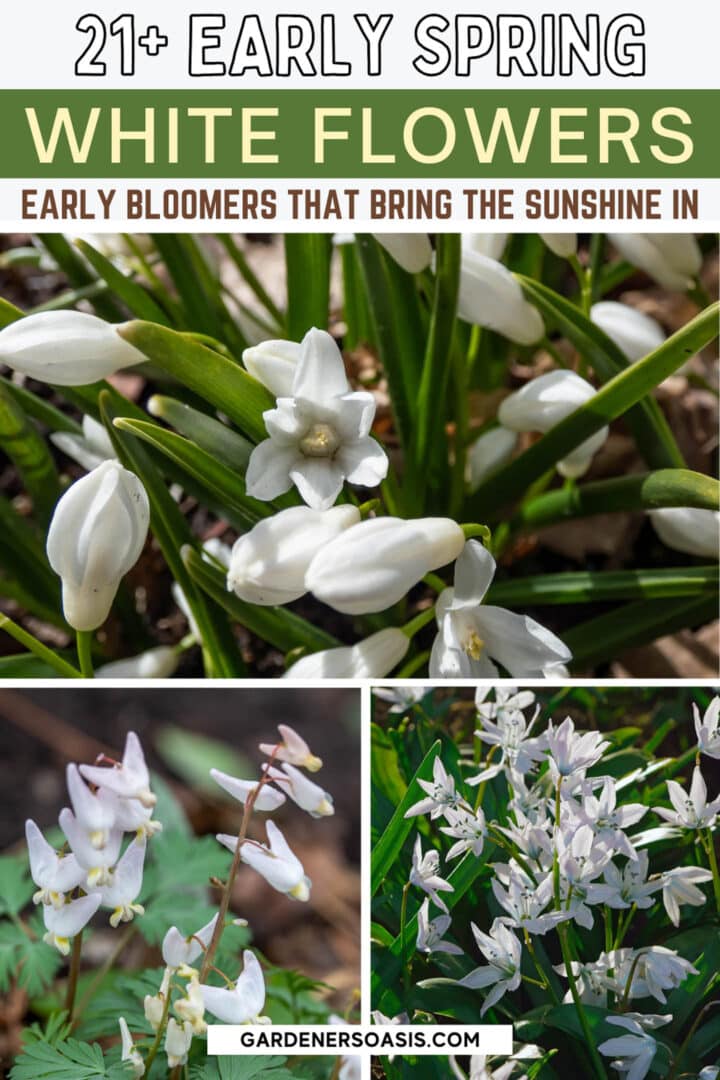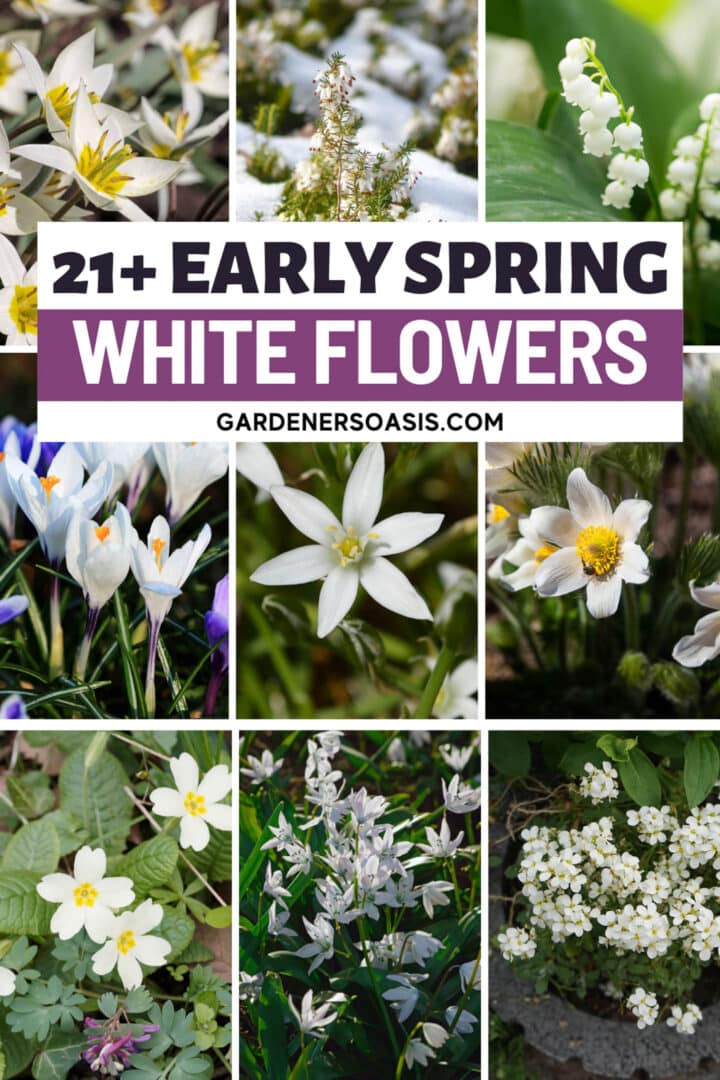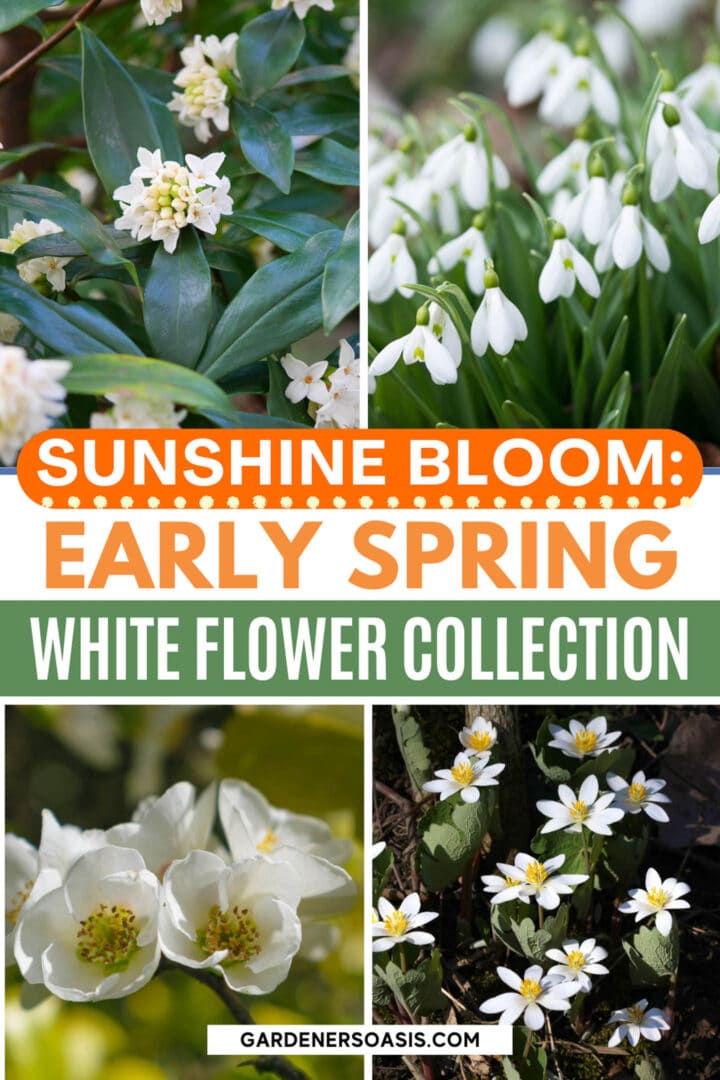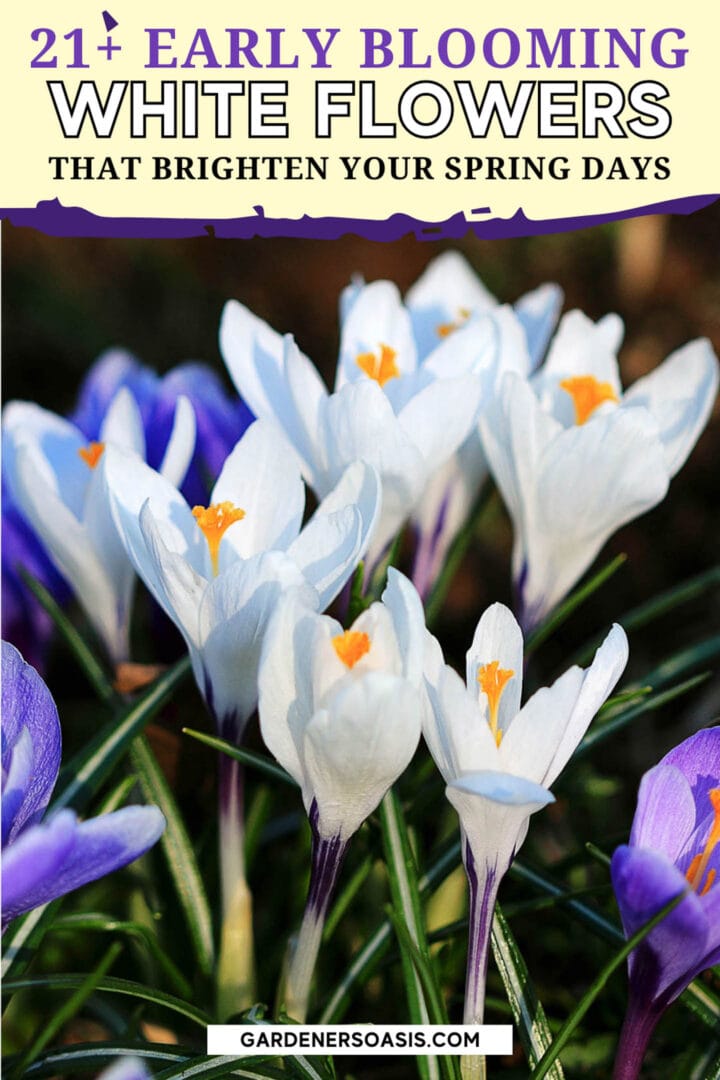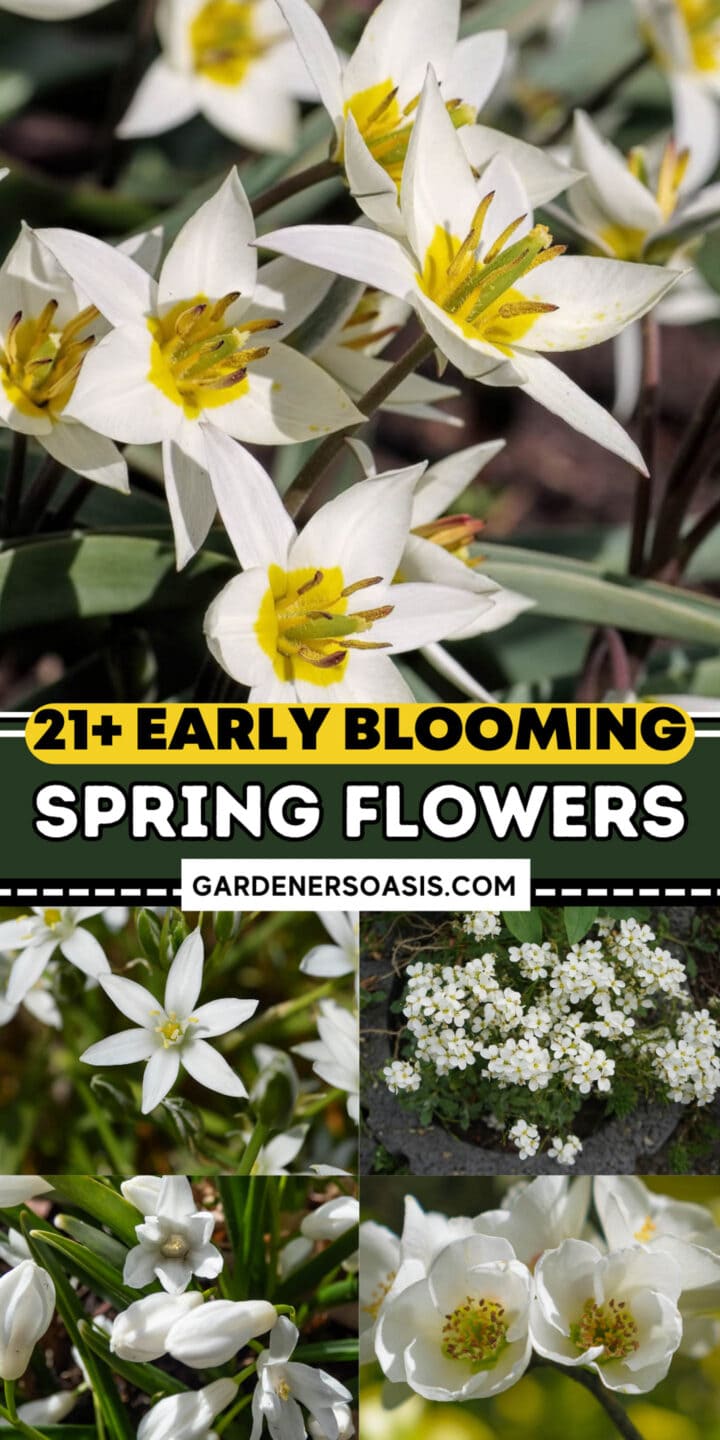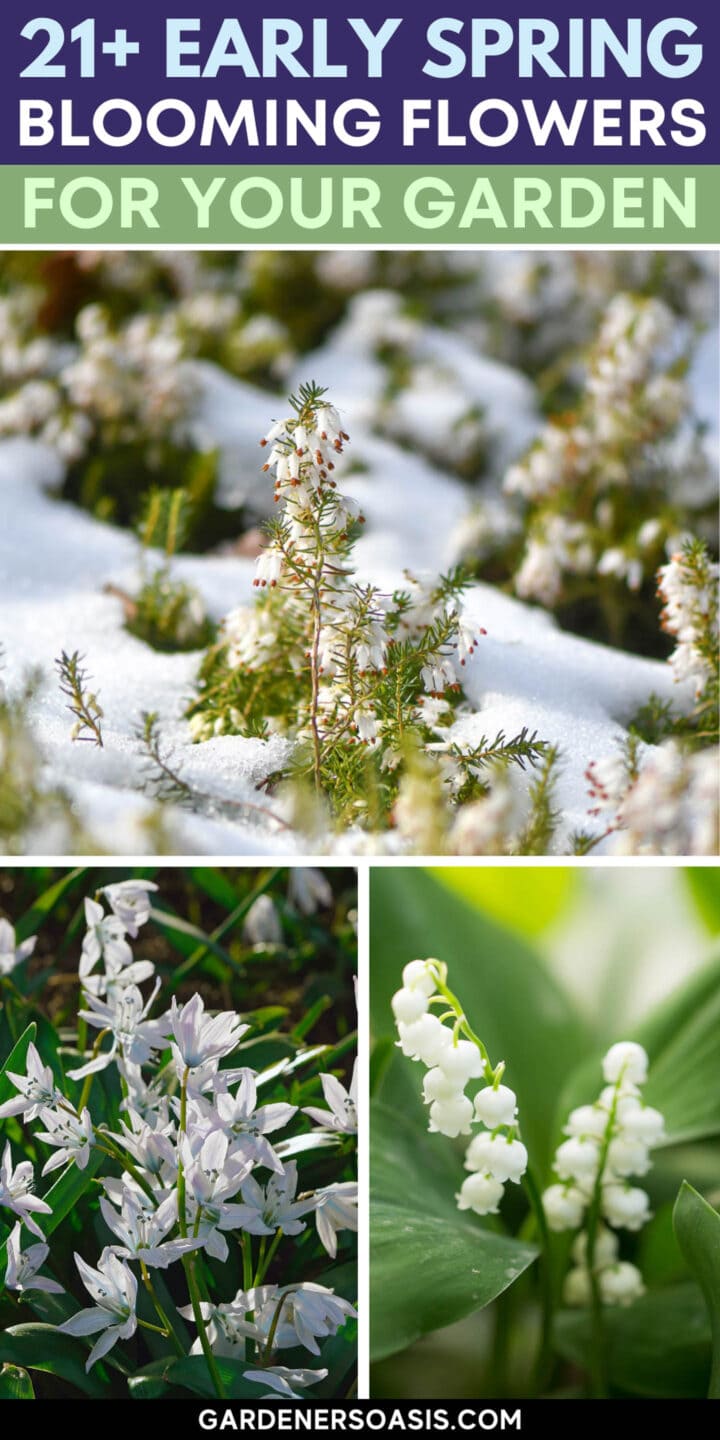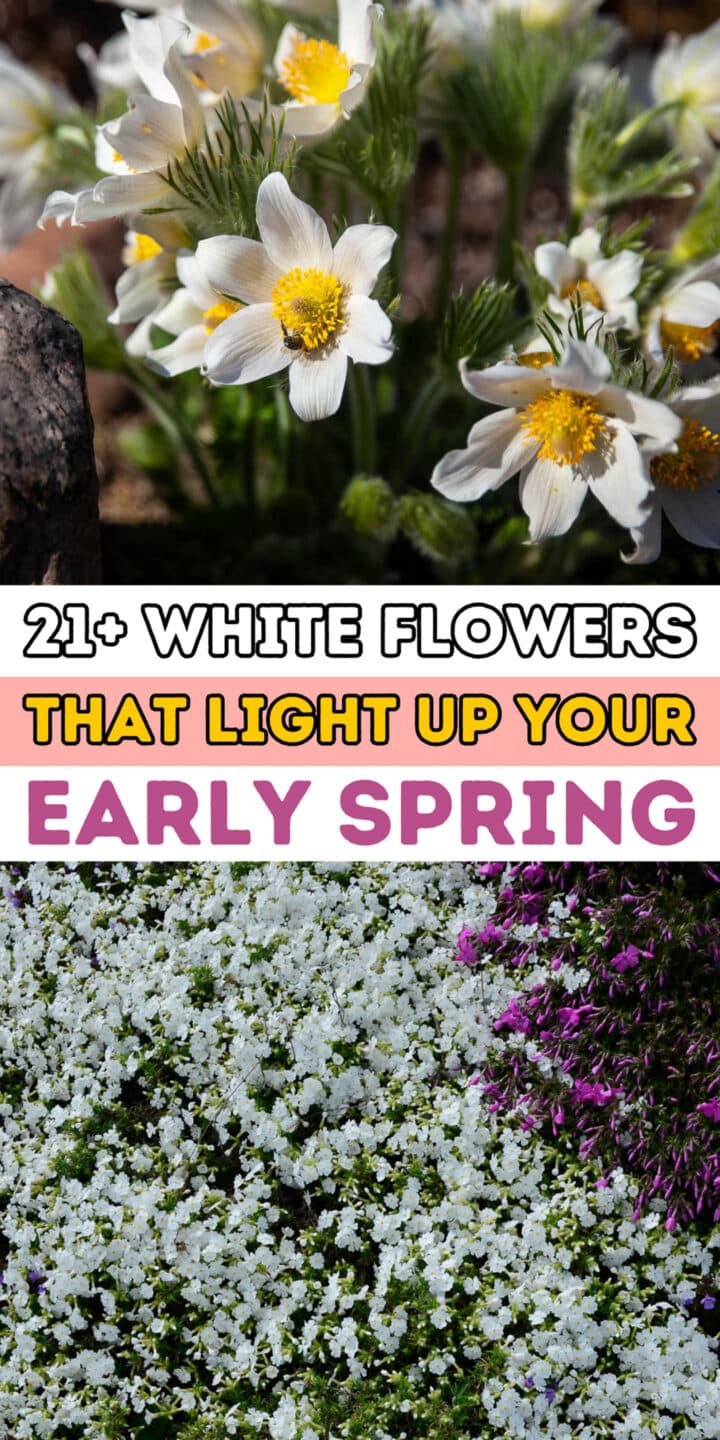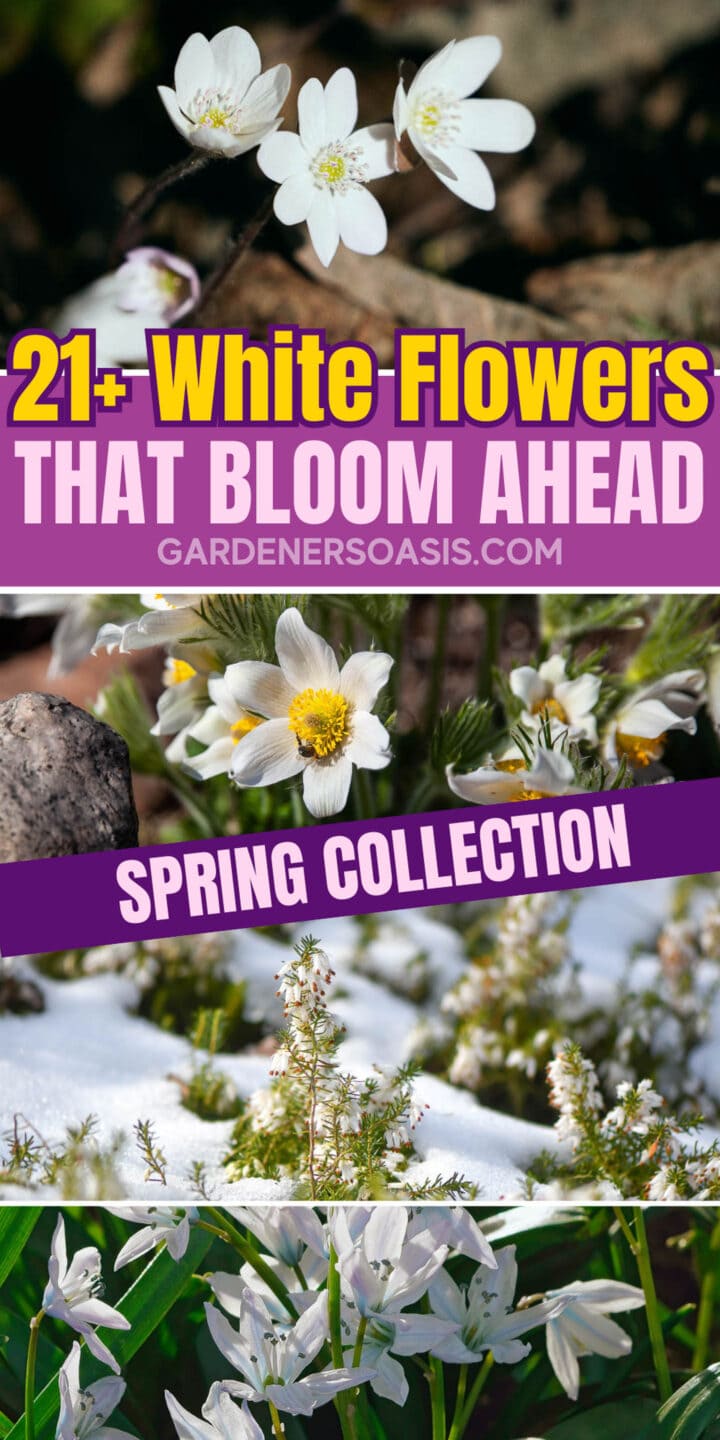21+ Early Spring White Flowers
These early spring white flowers are the first plants that come into bloom after the dreariness of winter are the most welcoming sight. They make us feel that the garden is waking up and better weather is on the way.
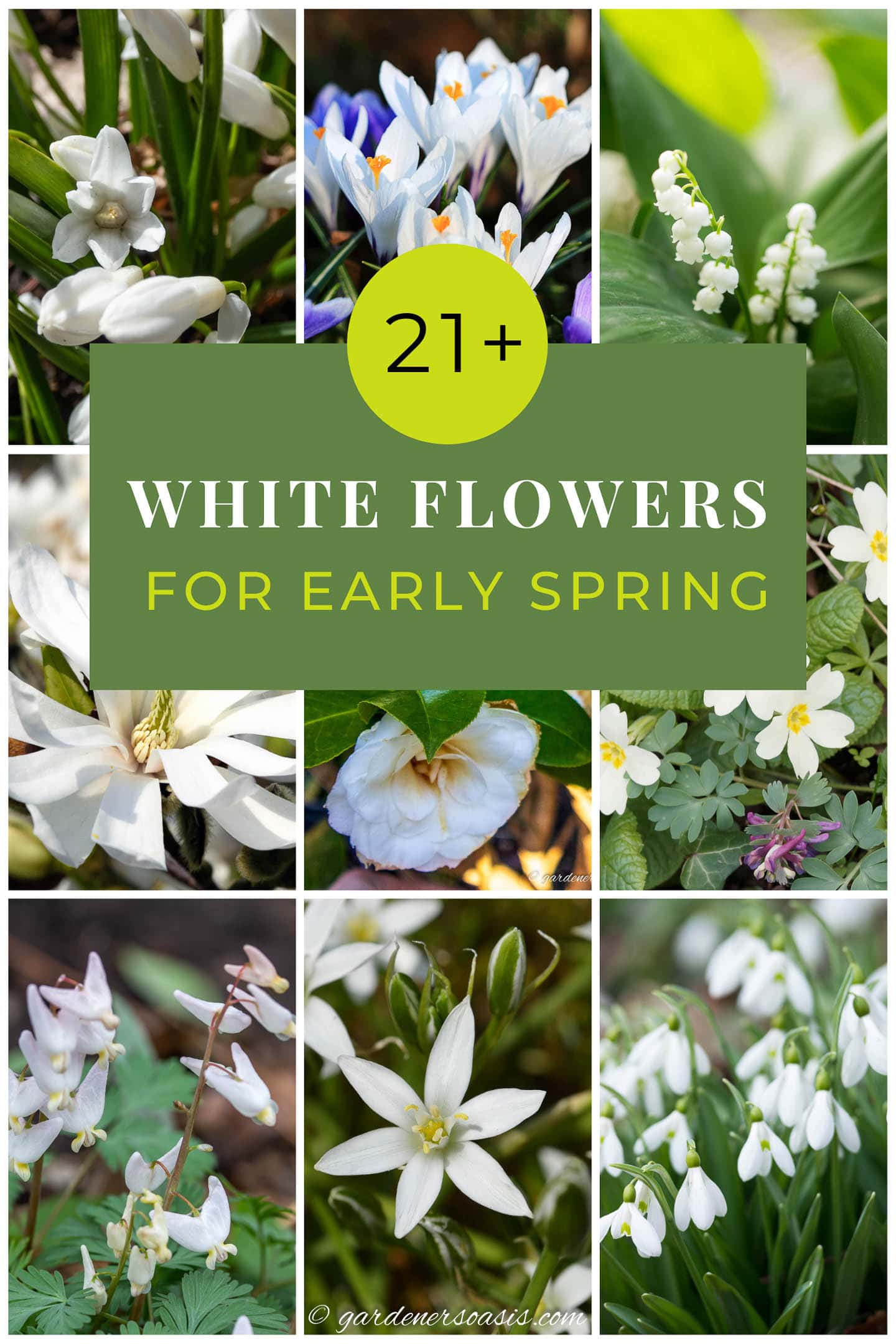
Ever since Vita Sackville-West created her famous white garden at Sissinghurst in the 1930s, gardeners everywhere have been fascinated with white blooming plants.
So if you are one of those who aspire to emulate the monochromatic ‘white’ look, or if you just love blooms that are white, I have put together a list of good early blooming candidates for your consideration.
This list contains bulbs, perennials and shrubs that make a gorgeous welcome sight (and aroma) in the late winter or early spring garden. And I love them for their easy care and reliability.
1 | White crocus ‘Jeanne d’Arc’
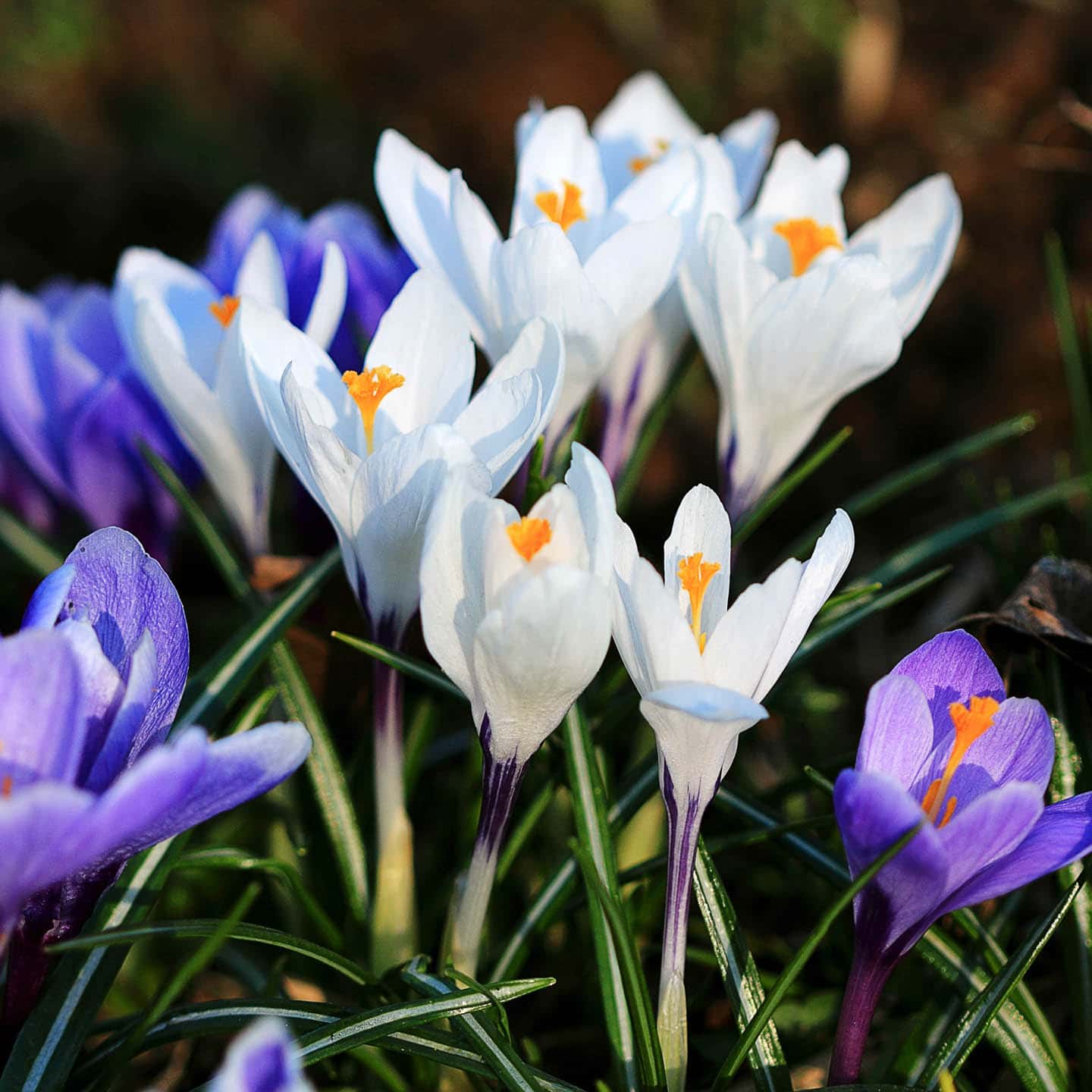
Scientific name: Crocus vernus ‘Jeanne d’Arc’
Zone: 3 to 9
Exposure: sun, part shade
Height: 4″ to 6″
Width: 3″ to 4″
Bloom time: early spring
Bloom color: pure white
Jeanne d’Arc is a large snowy white cup shaped flower that blooms just before the grass-like foliage appears. It is one of the earliest harbingers of spring.
Plant the bulbs clumps of 10 or more, in well drained soil, 3 to 4 inches deep in the fall.
They will naturalize under deciduous trees and shrubs or in the border before the leaves sprout.
2 | Snowdrops
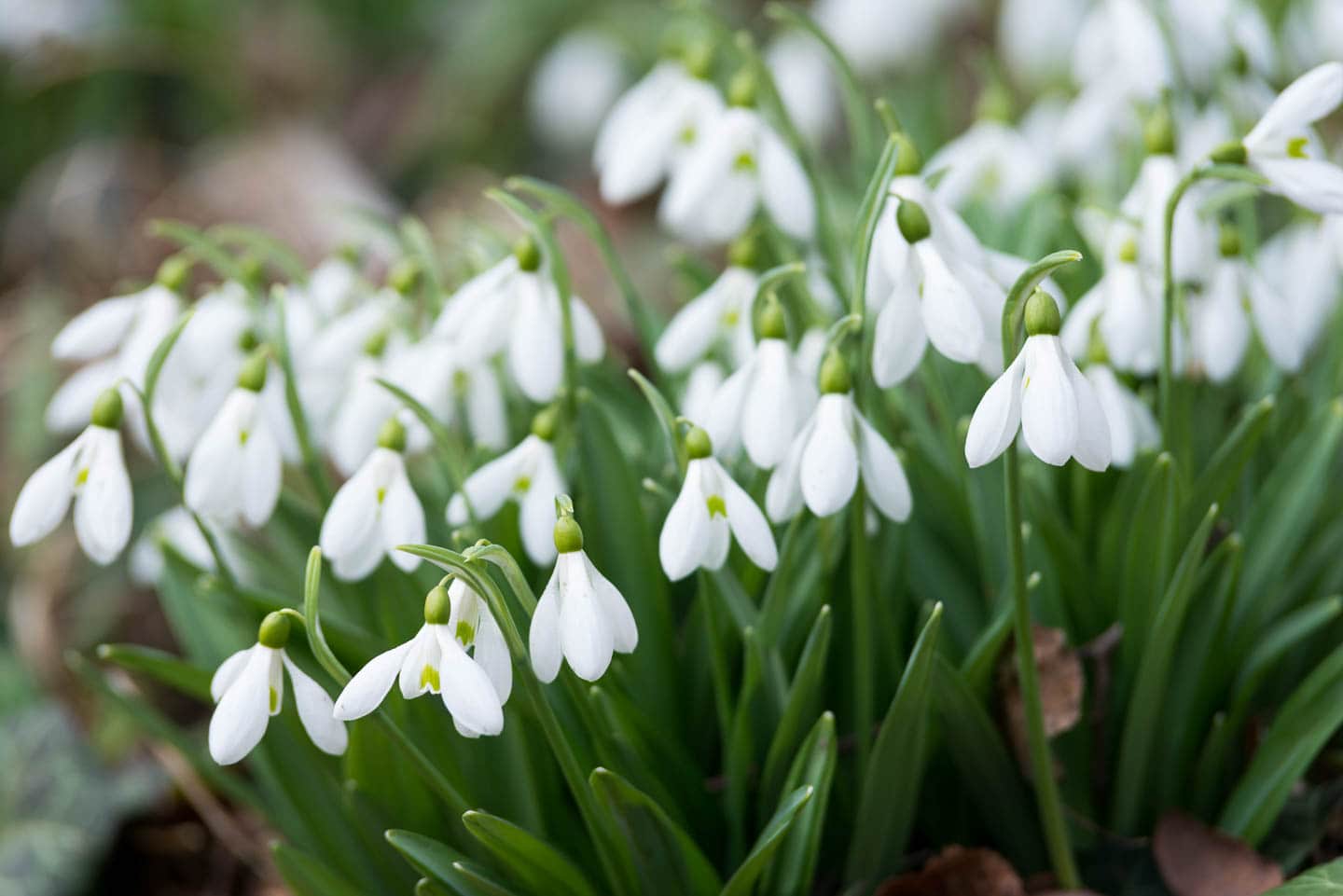
Scientific name: Galanthus nivalis
Zone: 3 to 8
Exposure: part shade
Height: 8″ to 10″
Width: 3″ to 6″
Bloom time: late winter, early spring
Bloom color: white with a green spot at the apex
Galanthus have small nodding teardrop white flowers that are one of the first to emerge in the late winter.
The gray-green grass-like foliage come up just prior to the blooms and dies back in late spring.
It has been awarded the RHS Award of Garden Merit for its excellence.
Plant the small bulbs in drifts 2 to 3″ deep in woodland areas where they will naturalize quickly.
They are deer, vole, and rabbit resistant.
3 | White squill
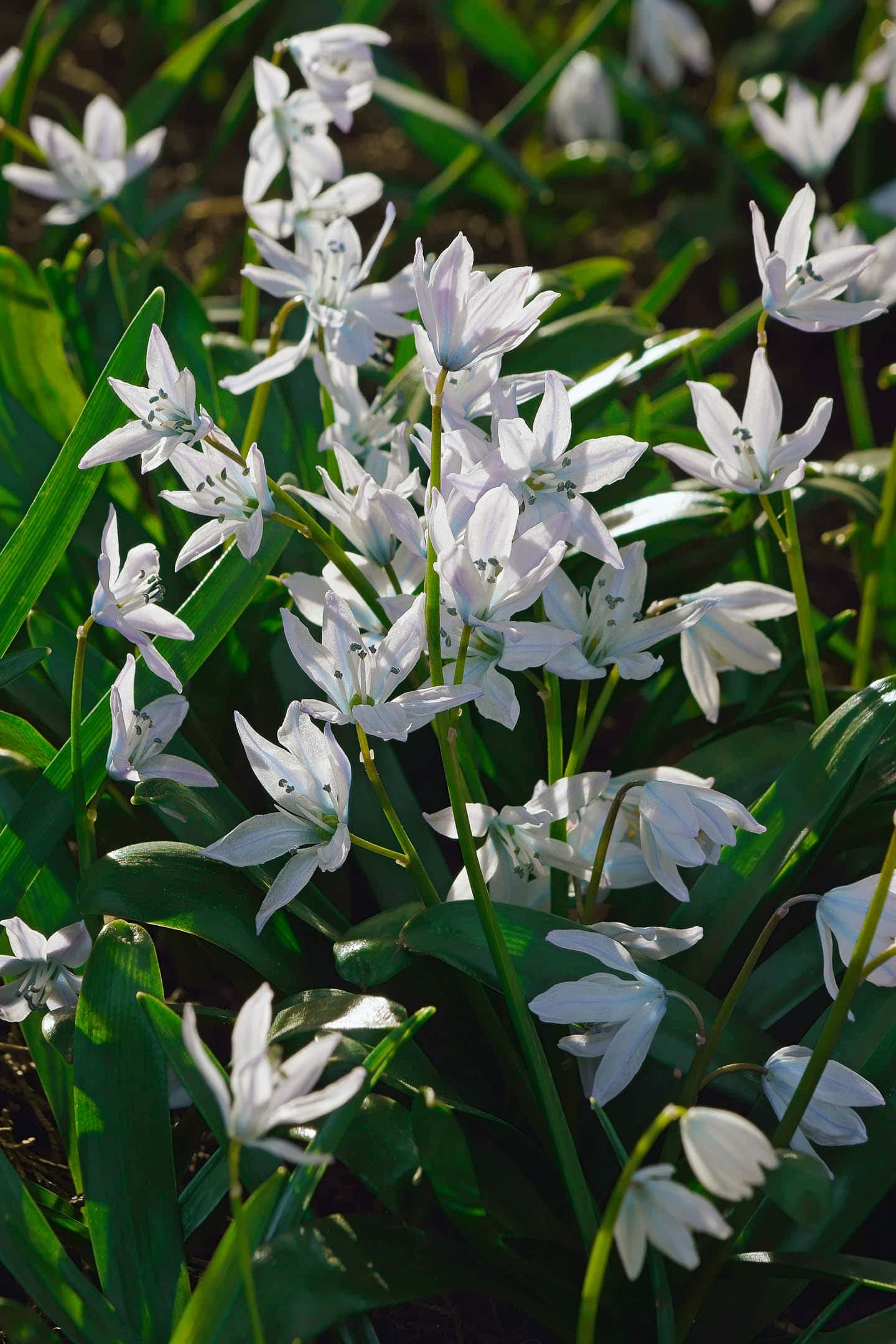
Scientific name: Scilla mischtschenkoana
Zone: 4 to 8
Exposure: sun, part sun
Height: 3″ to 6″
Width: 3″ to 6″
Bloom time: late winter, early spring
Bloom color: white
Another RHS Award winner, the white squill is repugnant to rodents and deer.
It naturalizes rapidly, even in the shade of shrubs and roses where you can enjoy a multitude of lovely star-shaped blossoms covering strappy green foliage.
Plant this small inexpensive bulb in drifts 3 to 4″ deep in well drained soil.
4 | White Glory of the snow
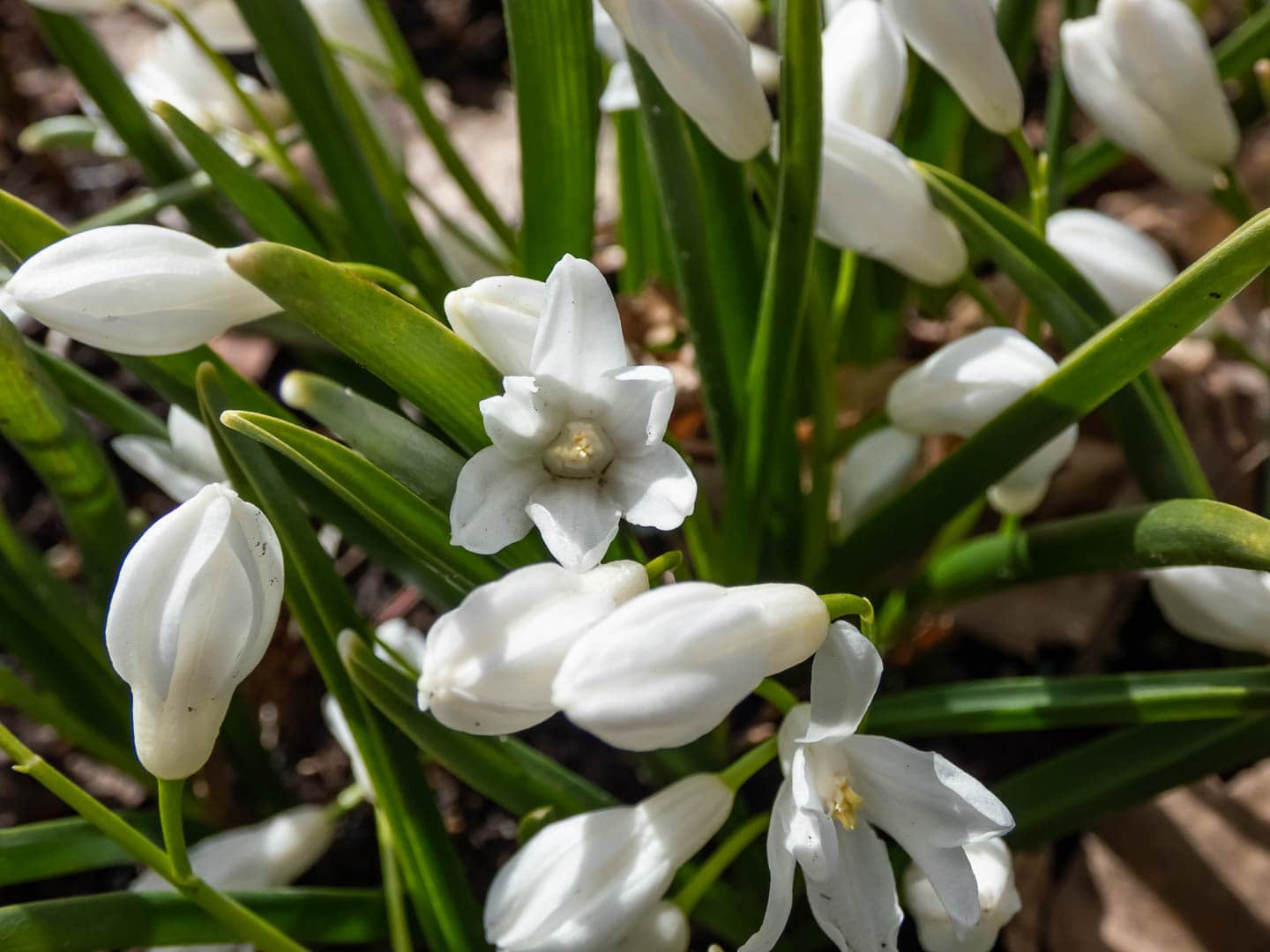
Scientific name: Chionadaxa luciliae ‘Alba’
Zone: 3 to 8
Exposure: full sun, part sun
Height: 3″ to 6″
Width: 3″ to 6″
Bloom time: early spring
Bloom color: white
White Glory of the Snow has charming 6-petalled pure white blossoms on short stems above narrow, semi-erect basal leaves for a star studded effect.
It looks great in sweeping expanses under deciduous bushes, in rock gardens, lawns, or in the woodland garden.
Plant the small bulbs in drifts of at least 15 per clump about 4″ deep in well drained soil.
They will naturalize readily, especially if the foliage is allowed to die back naturally which allows the bulbs to gather nutrients for next year’s crop of blooms.
Alba is a disease resistant care-free plant that repels critters and deer.
5 | ‘White Star’ Spring Starflower
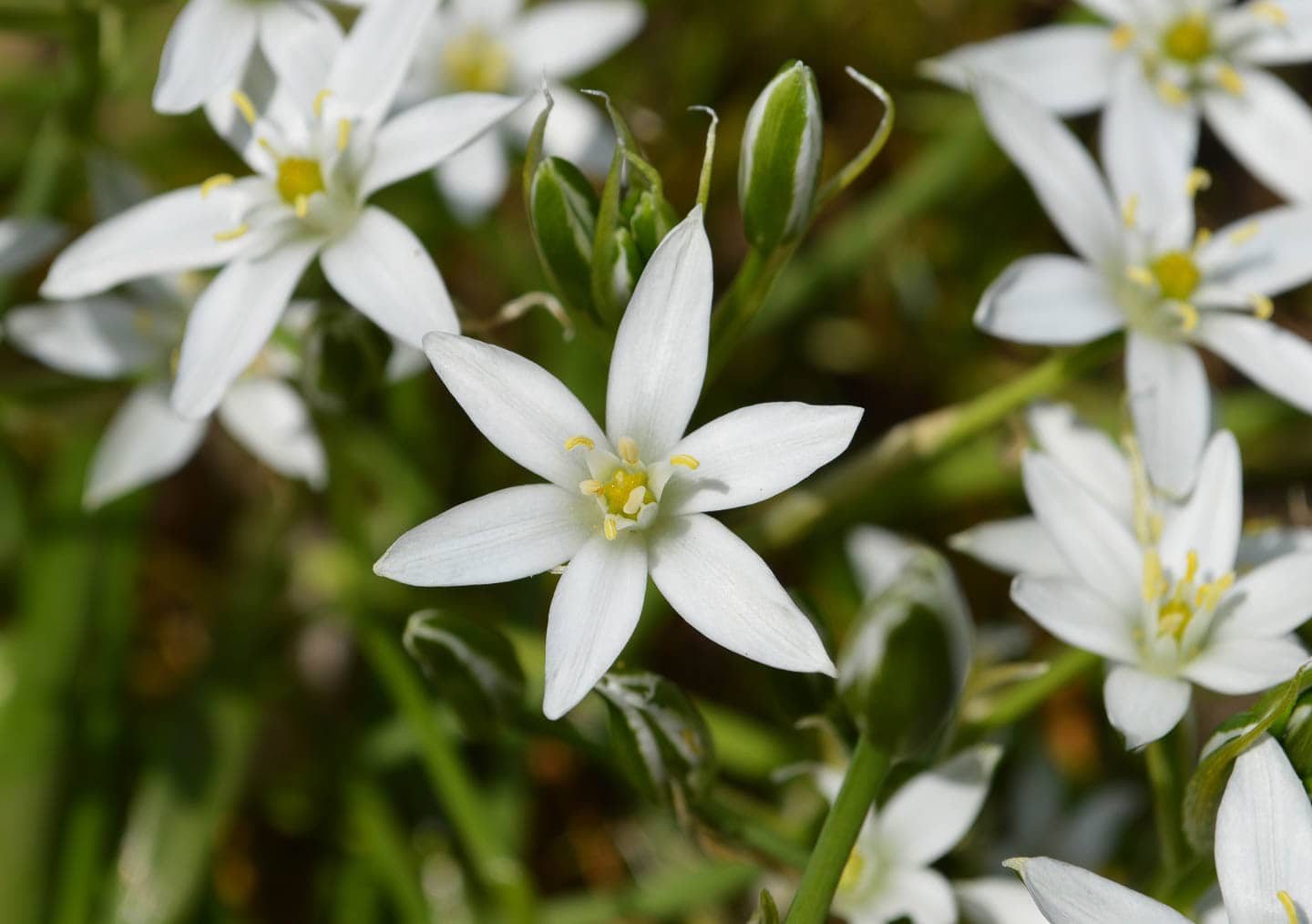
Scientific name: Ipheion uniflorum ‘White Star’
Zone: 5 to 9
Exposure: sun, part sun
Height: 3″ – 6″
Width: 3″ – 6″
Bloom time: spring
Bloom color: white
White star ipheion has star-shaped small white aromatic blossoms above light green thin leaves.
They look good in clusters in the rock garden, or in drifts along paths.
These are easy to grow when planted in well-drained humous rich soil about 2″ deep.
They naturalize readily by self seeding. Shear off the seed heads to prevent them from becoming invasive.
Like many other early spring bloomers, the plant goes dormant in the late spring.
Deer and rodents are not attracted to starflower.
6 | Species tulip
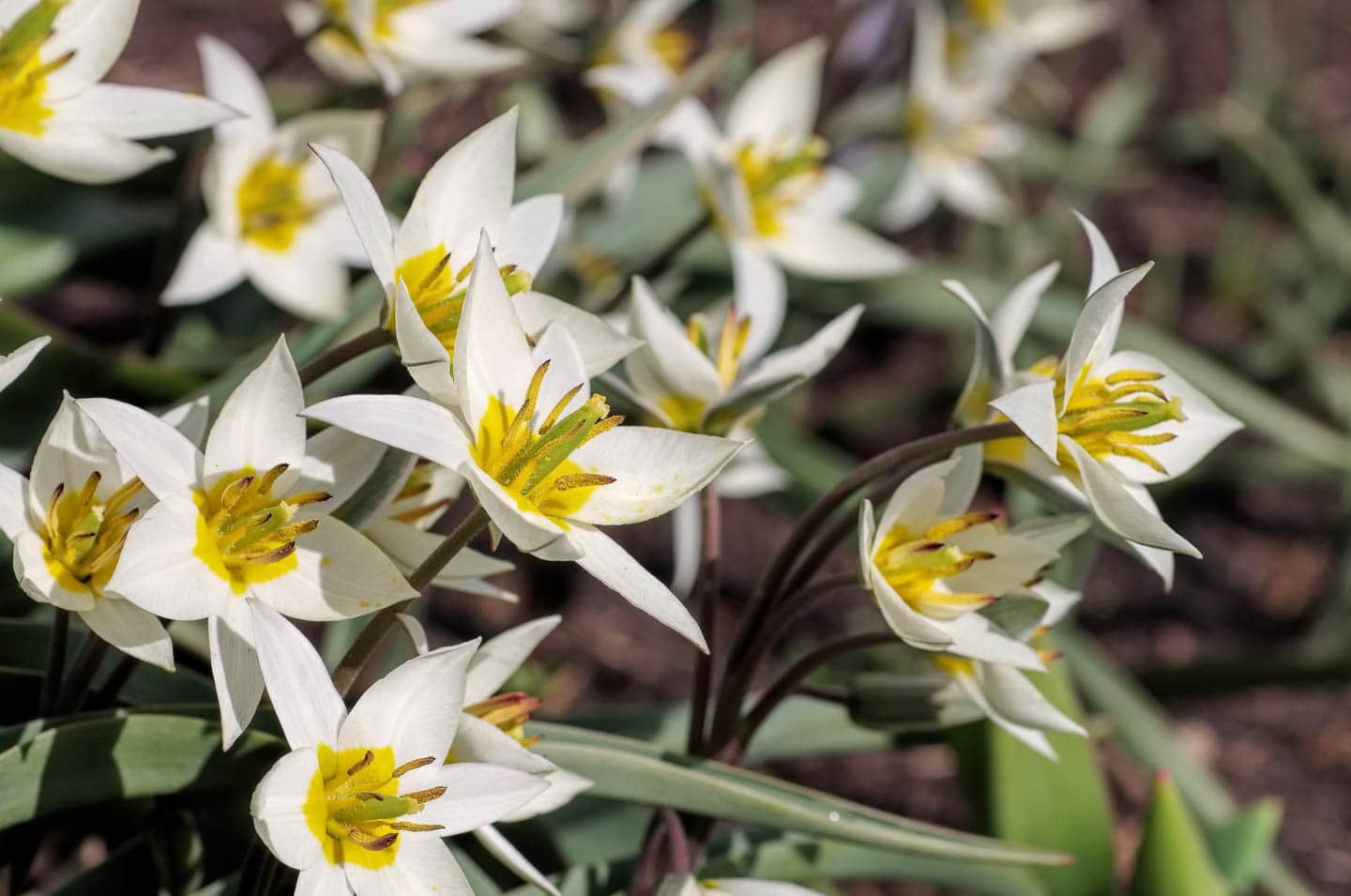
Scientific name: Tulipa
Zone: 3 to 8
Exposure: sun
Height: 6″ to 12″
Width: about 3″
Bloom time: early spring, spring
Bloom color: white with different colored centers depending on the variety
The species tulip is an unhybridized, wild small bulb that produces multi flowers per stem and often has thin stiped foliage. It will flower and naturalize even in the south because it does not need a prolonged chilling time.
If you want the plant to naturalize, do not deadhead the blooms and leave the foliage for at least 6 weeks before cutting it back.
Plant the bulbs in the fall, pointy end up, in rocky, well-drained soil, 8″ deep. They will look best if grouped in bunches of 5 or more near the edge of paths or in the rock garden.
These tough plants are reliable perennials. I prefer them to the larger hybrids that I treat as annuals.
Varieties
- Tulipa turkestanica (in the picture above)– creamy white star shaped flowers with a gold center. This plant produces 3 to 5 flowers per stem.
- Tulipa humilis var. pulchella Albocaerulea Oculata — pure white scented flower with blue center. Only 6″ tall.
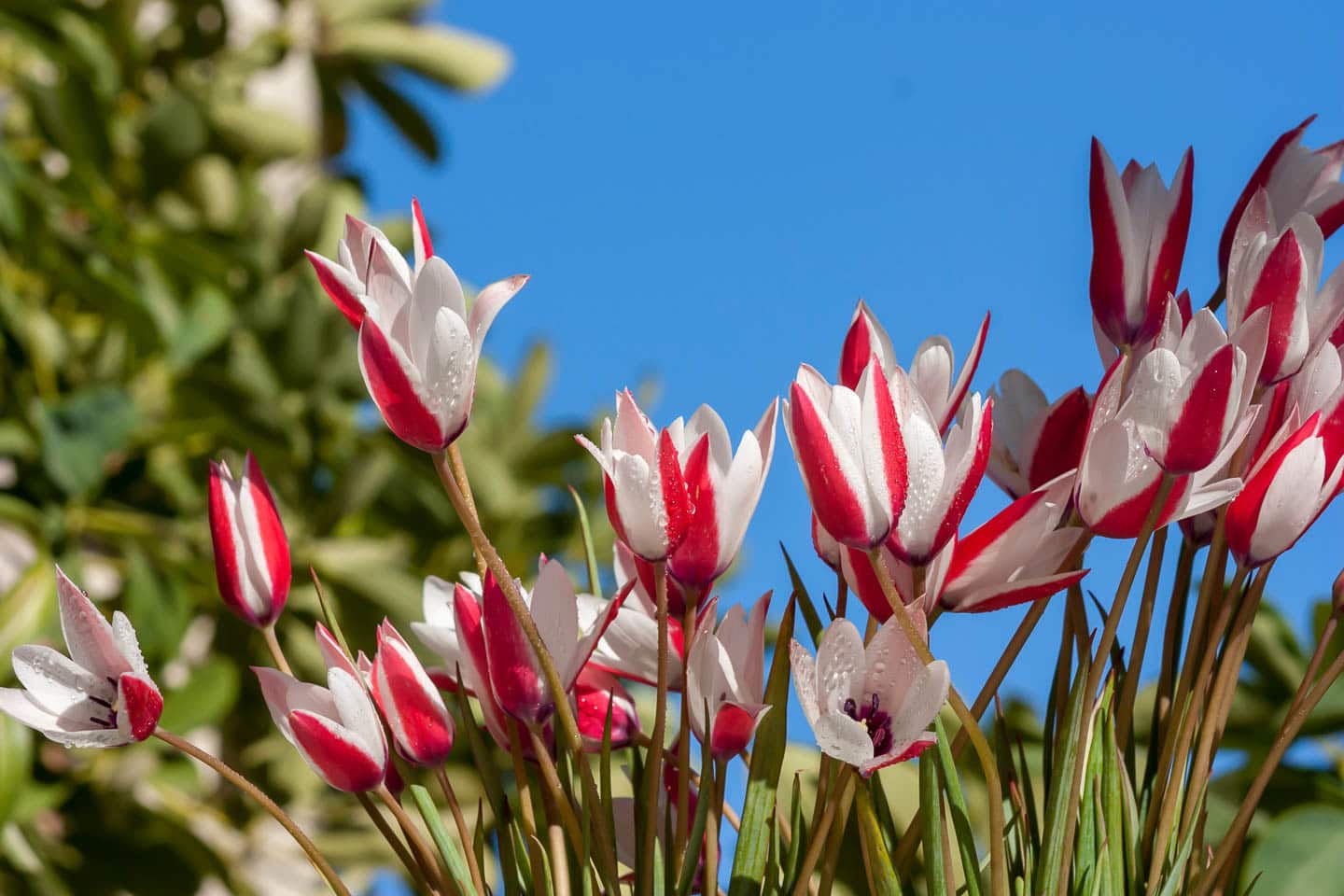
- Tulip clusiana (The Lady Tulip, Candy Cane Tulip, Lady Jane) — white petals with pink outside stripes and a purple center. A stunning charmer that grows 6″ to 10″ high.
7 | Virginia Spring Beauty
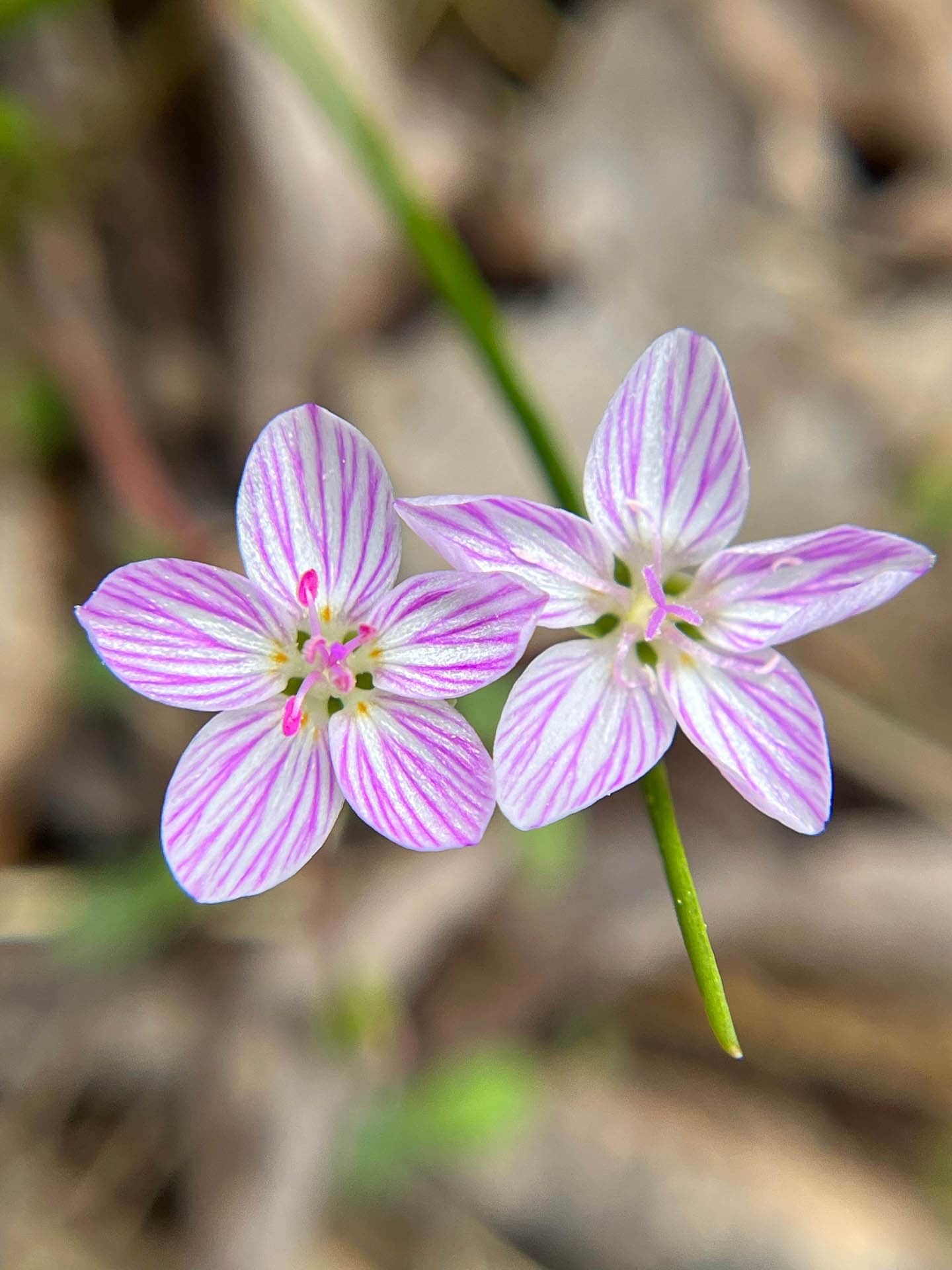
Scientific name: Claytonia virginica
Zone: 4 to 9
Exposure: full sun, part shade
Height: 6″ to 10″
Width: 6″ to 10″
Bloom time: early to late spring
Bloom color: white, pale pink with pink veins
Virginia spring beauty is a North American native that sports small star-shaped white flowers with purple veining above grass-like foliage.
Planted 3″ deep, in multiples, in the fall, this plant makes a pretty spring ground cover that readily naturalizes and enhances the look of the woodland garden.
It goes dormant after the plant has finished blooming so make sure to plant it with other perennials that will fill in the gaps.
It tolerates drought and acid soil, and attracts pollinators. The tubers are edible.
8 | White Pasque Flower
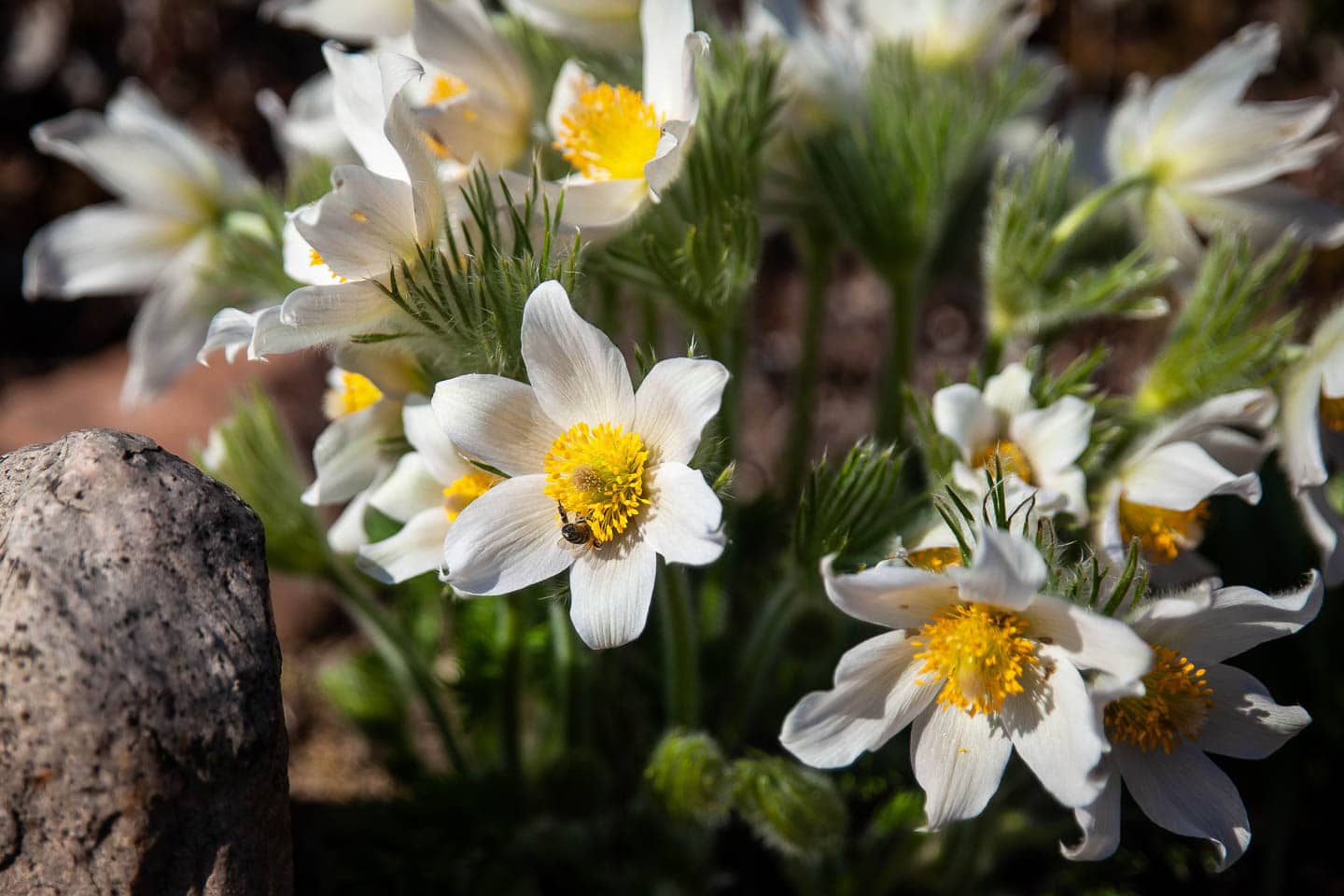
Scientific name: Pulsatilla vulgaris ‘Alba’
Zone: 4 to 8
Exposure: Sun
Height: 9″ to 1′
Width: 9″ to 1′
Bloom time: early spring
Bloom color: white with yellow stamens
White pasque flower has beautiful 3″ cup-shaped blooms held by short stems above ferny green foliage.
This plant forms a nice clump in the alpine, rock or front garden.
It self seeds, if you are lucky, and goes dormant in the summer.
The seed heads provide late spring interest.
Rabbits leave Pasque flower alone but it attracts early pollinators.
9 | White primrose
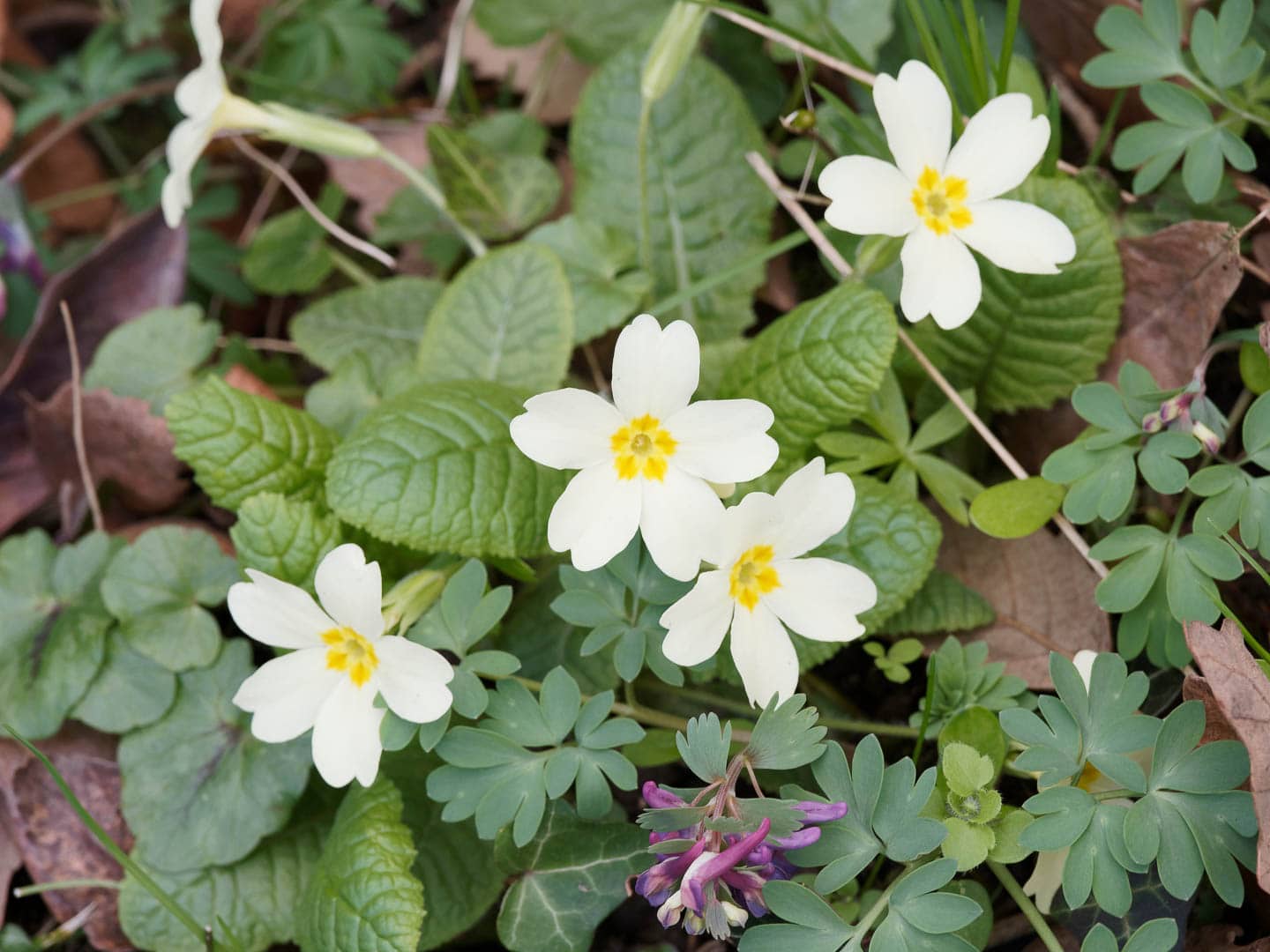
Scientific name: Primula vulgaris
Zone: 3 to 8
Exposure: part shade, morning sun only
Height: 6″
Width: 6′ to 8″
Bloom time: late winter, early spring
Bloom color: white
White primrose has rosettes of fragrant flowers that bloom above semi evergreen notched foliage and bring brightness to the woodland garden.
It dies back to the ground in the heat of the summer but reappears again in the cool days of autumn.
The plant spreads slowly by rhizomes and is very easy to grow.
Since there are many types of primrose, be sure to read the tag carefully when you are buying them to assure that you are getting a perennial variety which blooms early.
It is deer and rabbit resistant but attracts bees.
10 | Lenten Rose
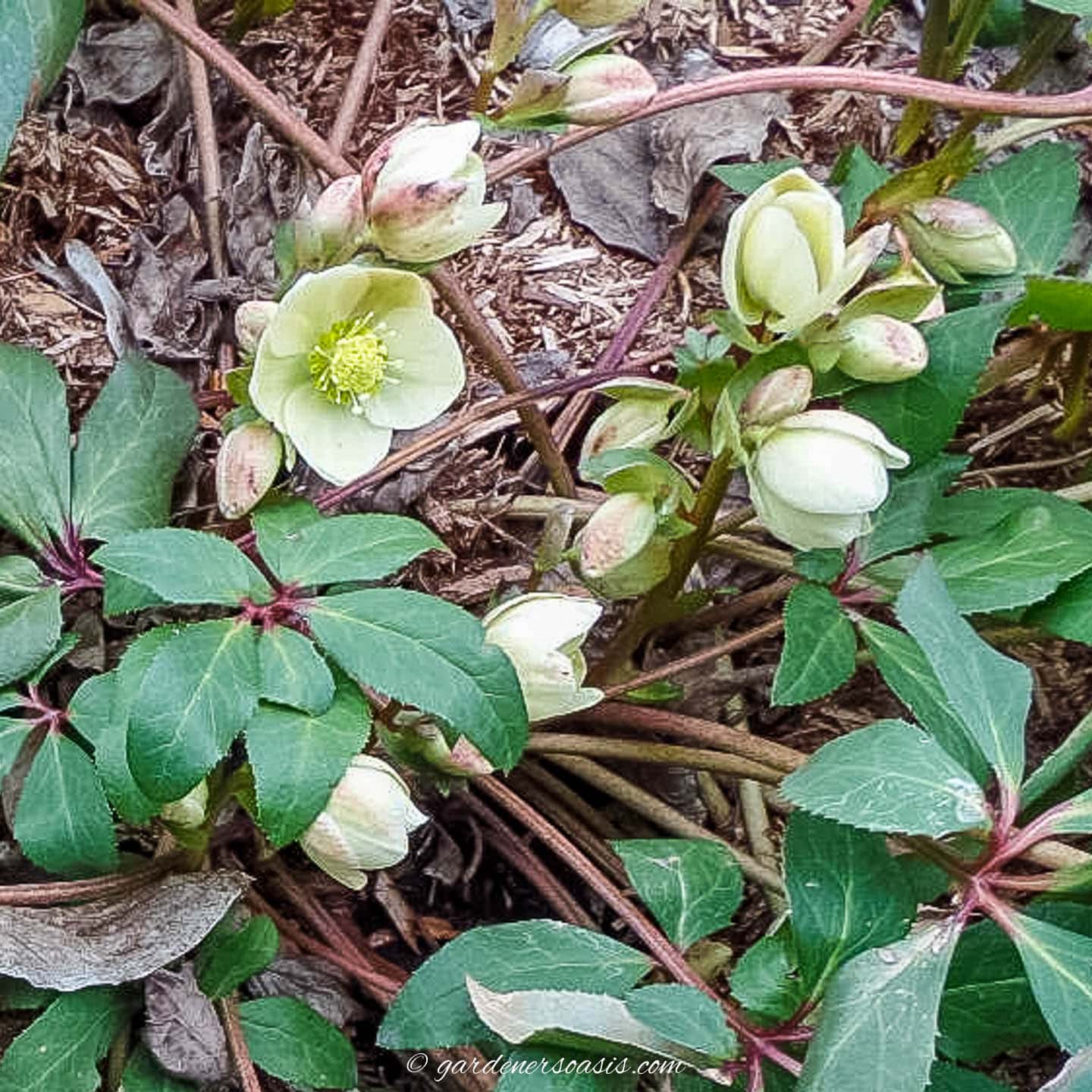
Scientific name: Hellebores orientelis
Zone: 4 to 9
Exposure: part shade, full shade
Height: 18″ to 2′
Width: 18″ to 2′
Bloom time: late winter, early spring
Bloom color: white, and many other colors
Hellebores are easy care perennials that need to be planted in the shade. They grow well under deciduous trees in very compost-rich, slightly alkaline soil.
My white blooming hellebores form buds under the snow and continue to flower all spring.
If you wish to fertilize, add some granular fertilizer in the spring. I do nothing to mine, once established, except remove dead or brown leaves.
Voles and deer do not eat Lenten Rose plants.
Varieties
- Molly’s white hellebore — upward facing white flowers with a greenish tinge.
- Helleborus Wedding Party ‘Wedding Bells’ — gorgeous pure white large, double ruffled blooms
11 | Bloodroot
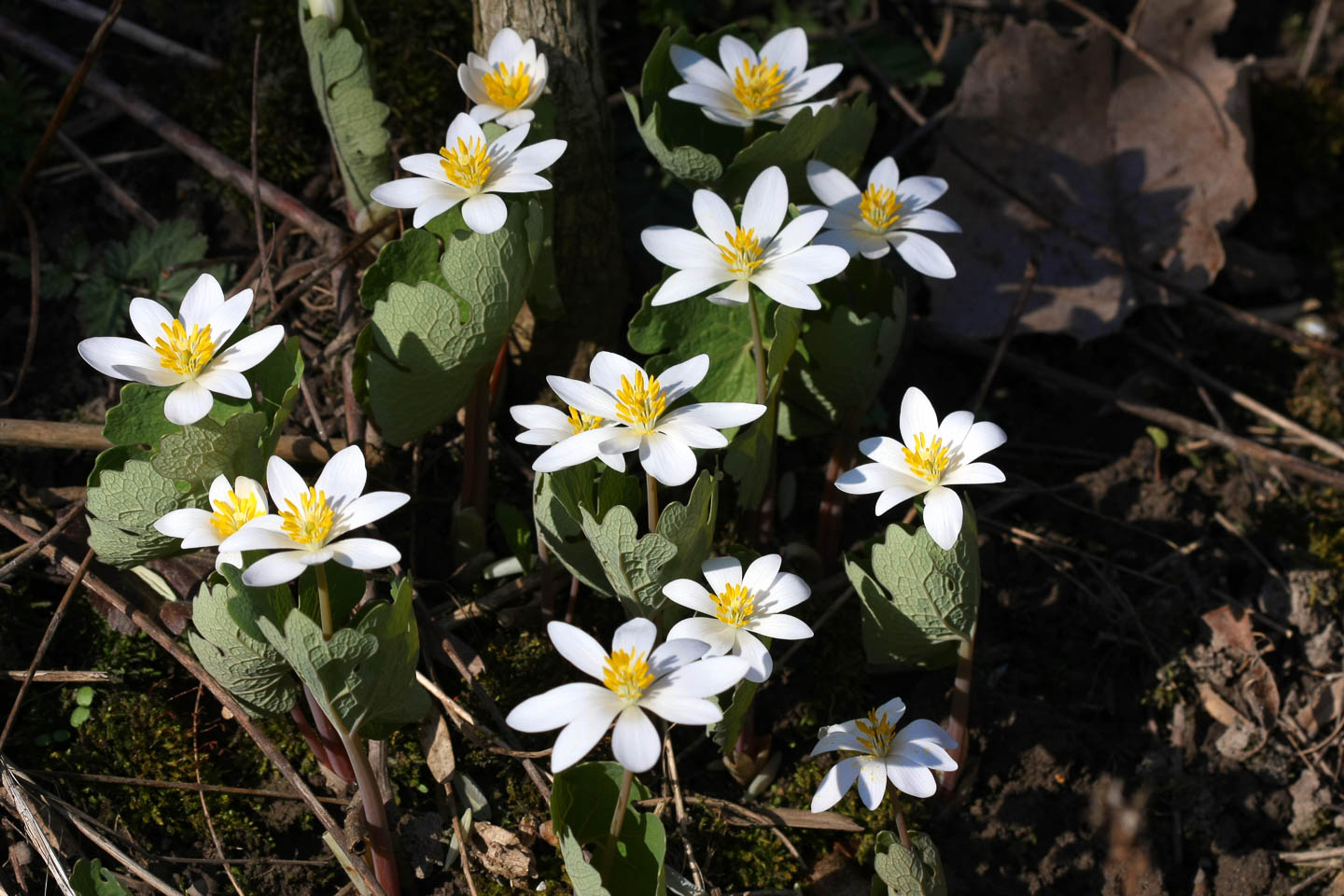
Scientific name: Sanguinaria canadensis
Zone: 3 to 8
Exposure: shade, part shade
Height: 6″ to 12″
Width: 3″ to 6″
Bloom time: early spring
Bloom color: white, sometimes pink tinged
Bloodroot is a rare eastern North American native with flowers that resemble daisies and come in single, semi-double and double varieties.
The flowers appear a couple of days before the blue/green foliage unfurls and stop blooming soon after they are pollinated.
This perennial spreads slowly by shallow, orange rhizomes, and seeds that are distributed by ants.
It likes moist, humous rich soil in shady woodland locations and goes dormant in the heat of the summer.
Bloodroot plants should not be harvested from the wild due to diminishing supplies.
12 | Creeping Phlox
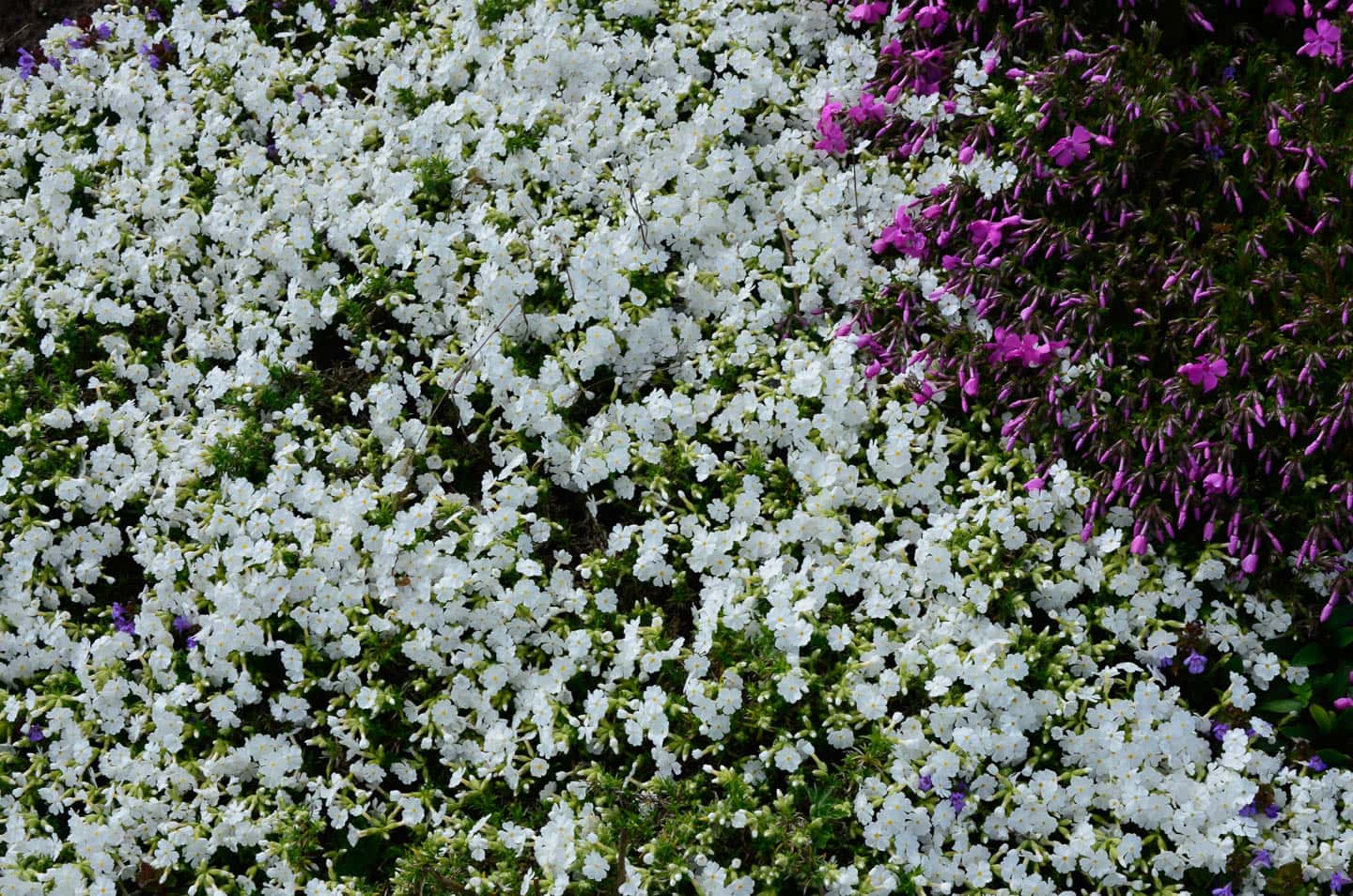
Scientific name: Phlox subulata
Zone: 2 to 9
Exposure: full sun
Height: 4″ to 6″
Width: 12″ to 24″
Bloom time: early spring
Bloom color: white
Creeping phlox forms a mass of white flowers covering evergreen, needle-like foliage for about 4 weeks in early spring.
It looks beautiful draping over walls, bunched in the rock garden or informally edging garden beds.
Shear after blooming to maintain its neat appearance.
This carefree stunner is drought tolerant as well as deer resistant.
13 | Mountain Rock Cress
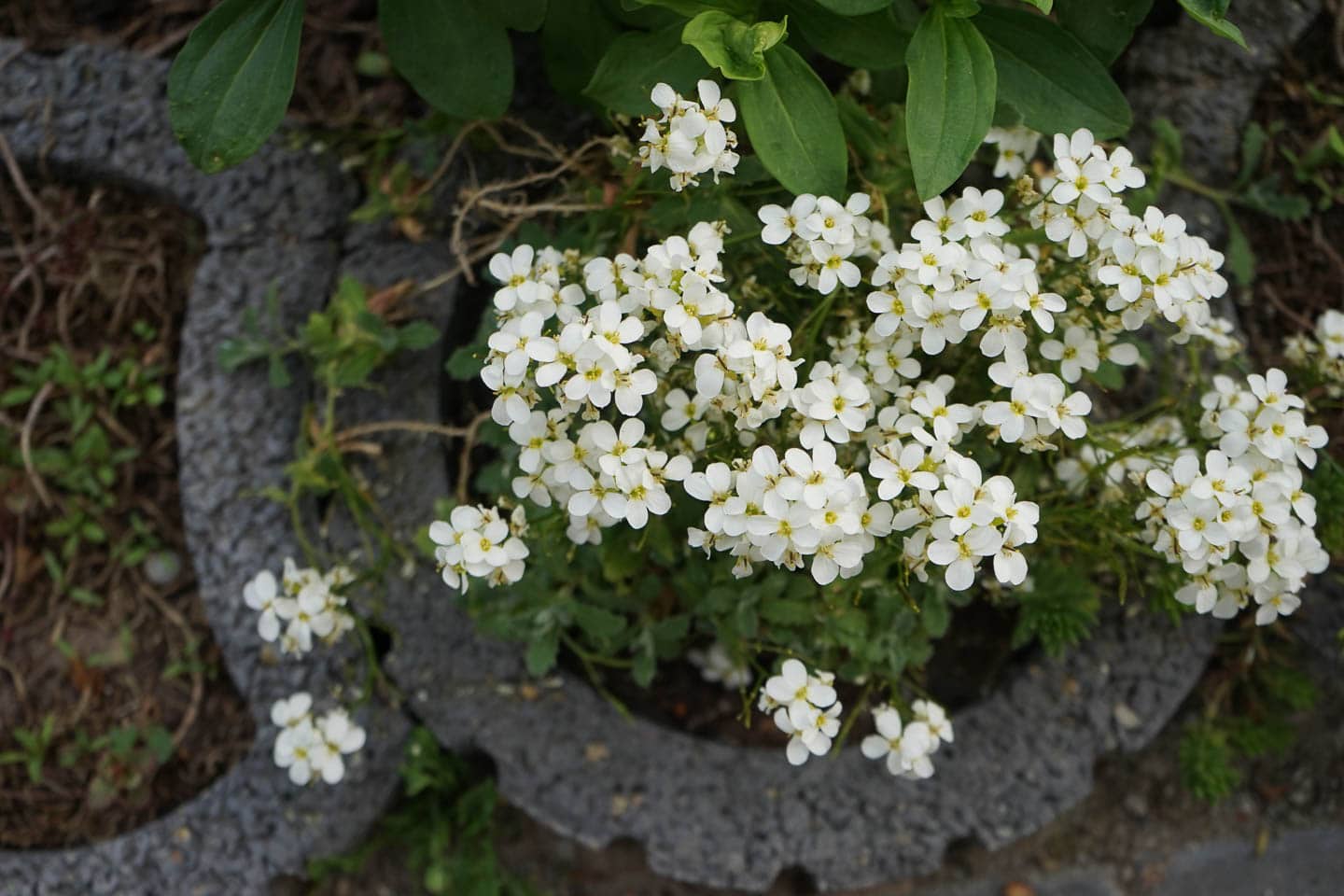
Scientific name: Arabis alpina subsp. caucasica
Zone: 3 to 8
Exposure: sun
Height: 8″ to 10″
Width: 1′ to 18″‘
Bloom time: early spring
Bloom color: white
Mountain rock cress is an evergreen perennial with masses of fragrant, white blooms over rounded grey/green leaves.
It will grow to drape over walls and rocks in the rock garden.
This Canadian and northern USA native tolerates drought and poor gravelly soil. It repels deer and rabbits.
The plant needs to be cut back severely after blooming to keep it from growing leggy.
14 | Dutchman’s breeches
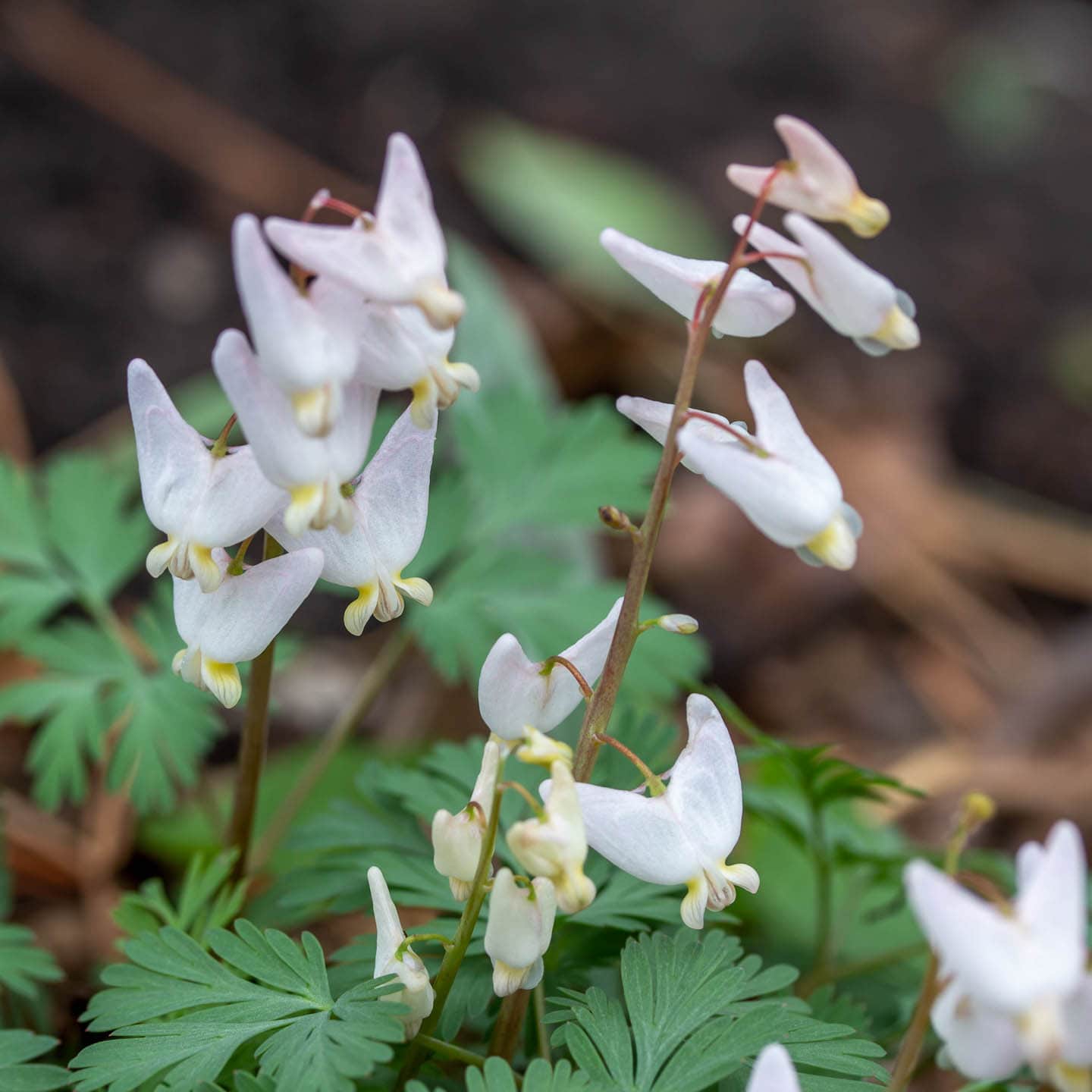
Scientific name: Dicentra cucullaria
Zone: 3 to 8
Exposure: shade, part shade
Height: 6″ to 12″
Width: 6″ to 12″
Bloom time: early spring
Bloom color: white
Dutchman’s breeches is an eastern north American native plant in the bleeding-heart family.
The white flowers, shaped like pantaloons, hang along the stem.
The finely cut, blue-green leaves form a delicate looking mound that disappears in the summer heat.
This plant will expand to cover a large area, if provided with humous rich, well- drained, slightly alkaline soil and partial shade.
Suitable sites are woodland gardens, cottage gardens, or as ground cover that is replaced later in the season.
Resistant to rabbits.
15 | Lily of the Valley
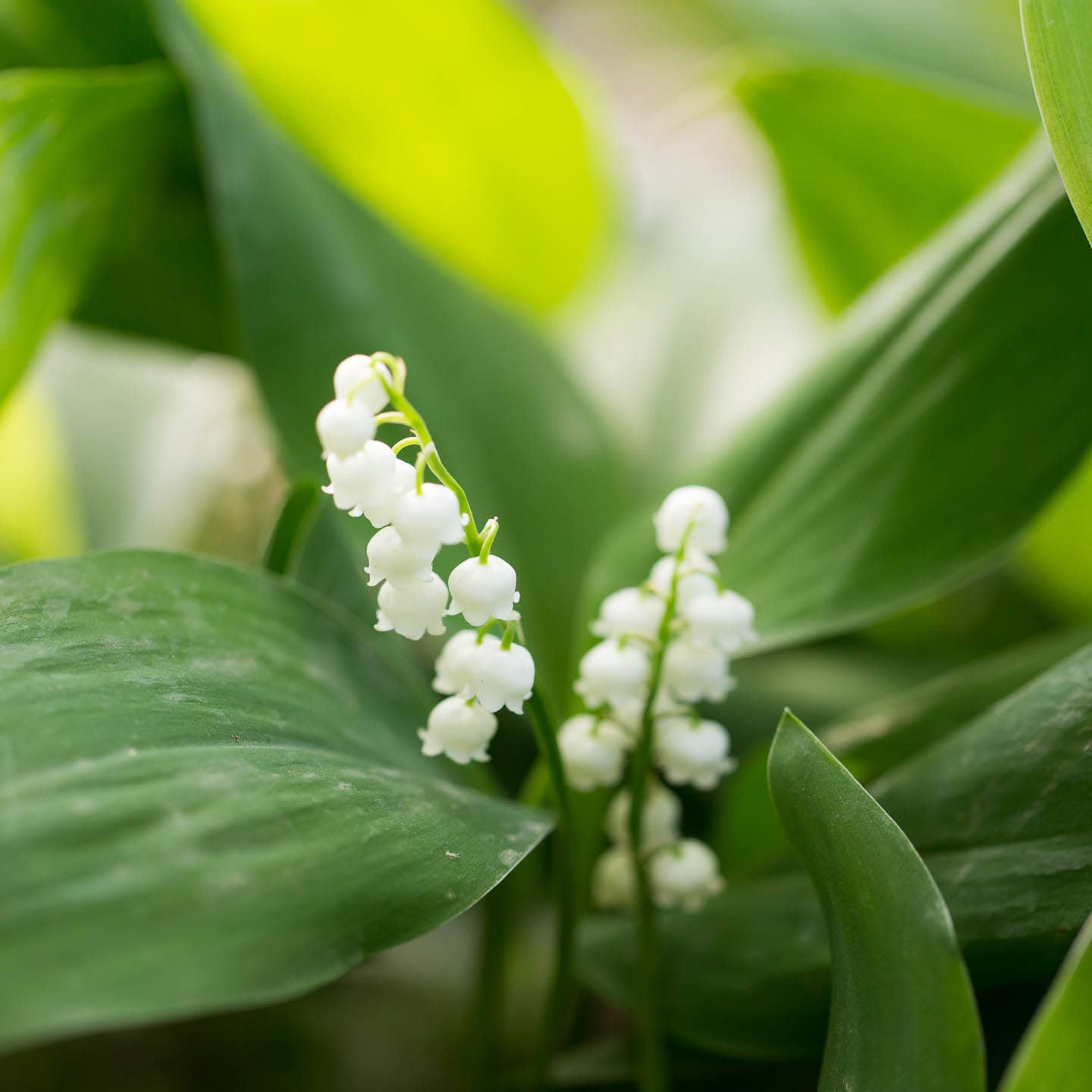
Scientific name: Convallaria majalis
Zone: 3 to 9
Exposure: part to full shade
Height: 6″ to 12″
Width: 6″ to 12″
Bloom time: early to mid spring
Bloom color: white or pale pink
Lily of the Valley has sprays of tiny, bell-shaped white flowers that dangle from sturdy stems, and are somewhat hidden by the shiny, dark-green, stiff, elliptical leaves.
The flowers look delicate and make a lovely small bouquet.
But the main reason to grow lily of the valley in your garden is for the distinctive, intense perfume it produces. The aroma will fill the entire area where the plants are located.
It likes shade and the green leaves remain all summer (unlike many of the other early spring white flowers).
I find convallaria to be invasive unless it is planted in an enclosed space, such as beside a walkway or driveway. Otherwise, it will spread by underground runners very quickly.
Deer don’t like it. It is poisonous to humans if ingested.
16 | Liverleaf
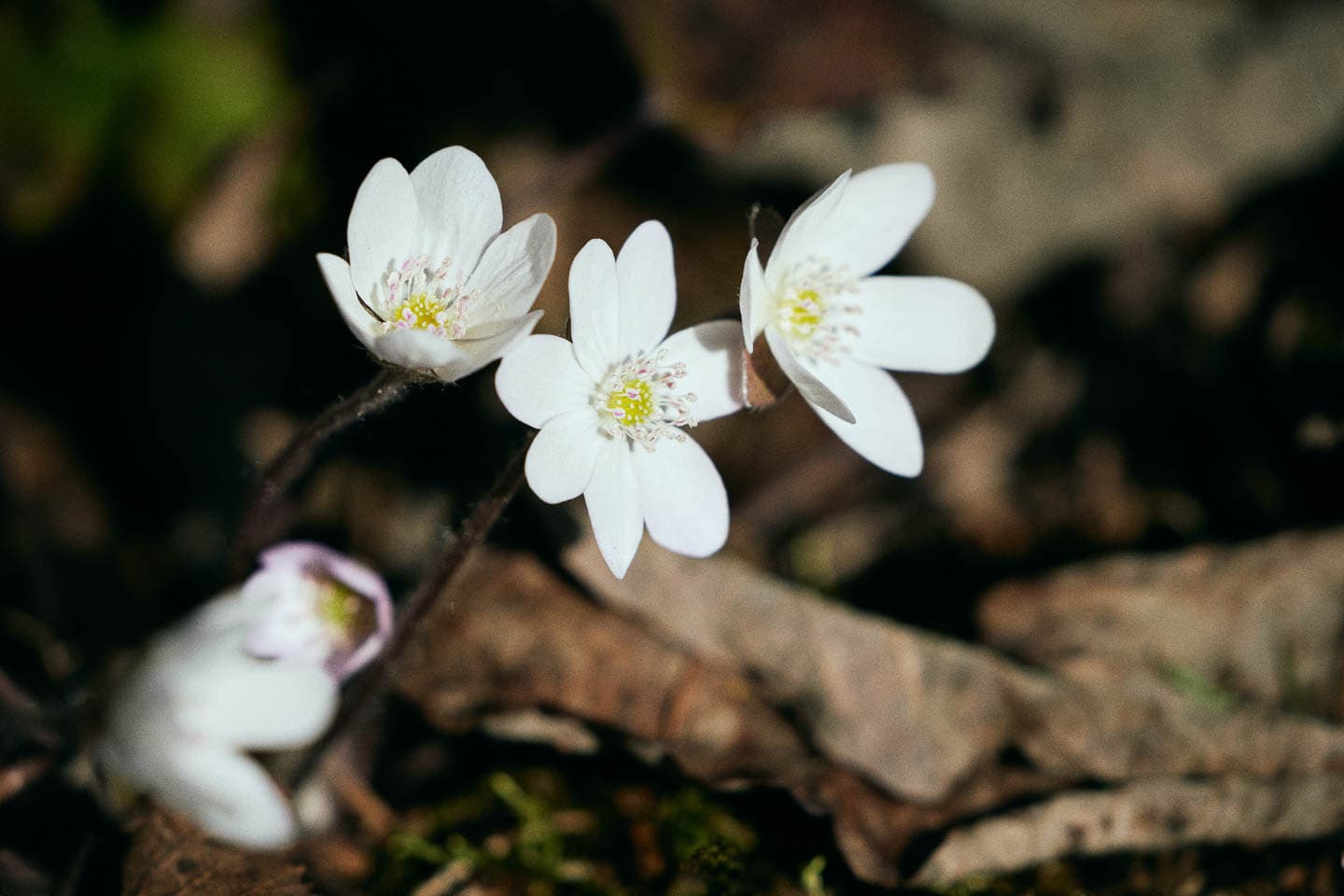
Scientific name: Hepatica nobilis
Zone: 5 to 8
Exposure: shade, part shade
Height: 3″ to 4″
Width: 4″ to 5″
Bloom time: early spring
Bloom color: white, pink, purplish/blue
Liverleaf is a charming small native to eastern North America, that thrives in humous-rich evenly moist soil.
The flowers are single, occasionally double, star-shaped with hairy stems. The semi-evergreen leaves are 3-lobed and silvery marked. This little gem has received the RHS prestigious Award of Garden Merit.
For the best visual impact plant en masse under deciduous bushes or along paths.
It needs a topdressing of leaf mold compost in the fall.
The roots of Hepatica resent disturbance so try not to move it after it has been planted.
17 | ‘Ice Princess’ Winter Heath
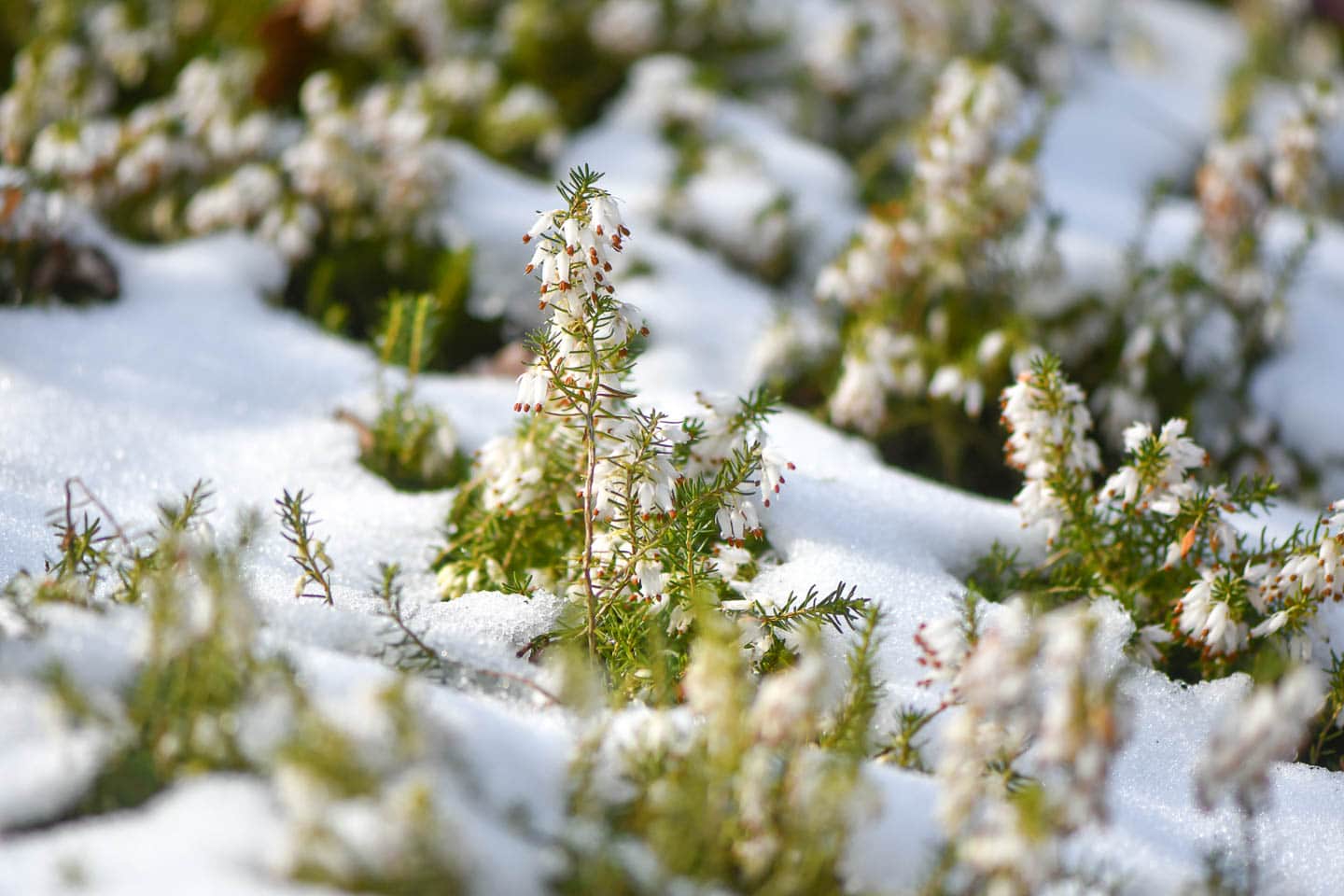
Scientific name: Erica carnea
Zone: 5 to 8
Exposure: sun
Height: 4″ to 6″
Width: 12″ to 18″
Bloom time: late winter to mid spring
Bloom color: white
Winter heath is sometimes classified as a bush in the literature.
However because it does not have distinct branches, I am calling it a hardy, easy care, perennial.
The evergreen, spikey leaves will be covered with a profusion of bell-shaped white blossoms in late winter and onward — the bleakest time of year in the garden.
And the neat mounds make a good groundcover.
A light shearing immediately after the blooms fade will insure an abundance of flowers next year.
Plant in acid soil, and full sun for the best blooms.
The nectar attracts bees but is avoided by deer. Salt and drought tolerant, once established.
This garden must have, is a winner of the RHS Award of Garden Merit.
Other white varieties:
- Erica carnea ‘Springwood White’ has a height of 8″ to 12″ and spreads to 24″.
- Erica x darleyensis ‘Silberschmelze’ is 1′ high and 3′ wide.
18 | American Pussy Willow
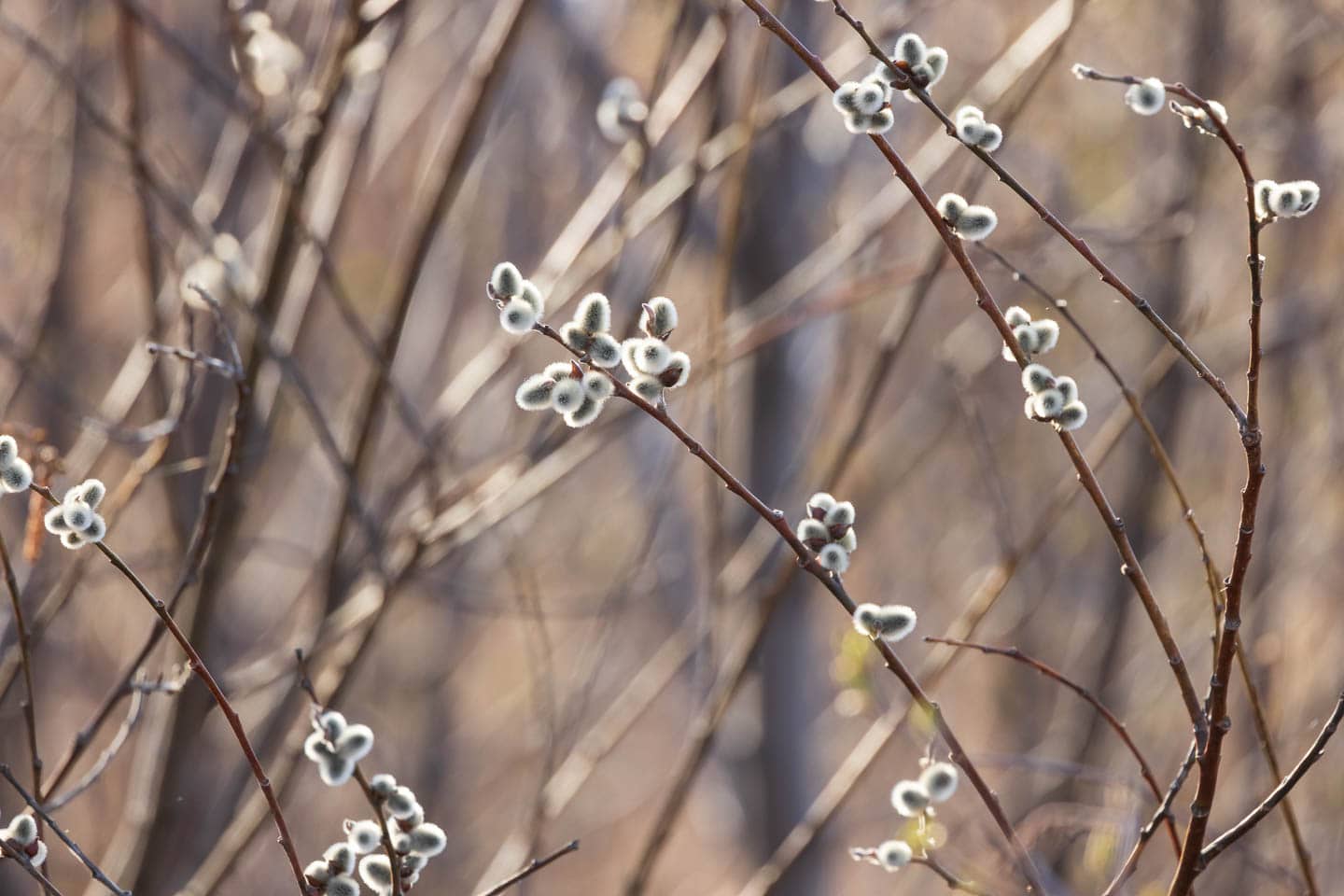
Scientific name: Salix discolor
Zone: 4 to 8
Exposure: sun, part shade
Height: 6′ to 15′
Width: 4′ to 12′
Bloom time: early spring
Bloom color: pearl gray/ whitish catkins on the male plant
This North American deciduous native shrub thrives in moist to wet conditions where little else will grow. It also tolerates black walnut, deer and erosion.
Be sure to purchase a male specimen to get the pearly white fluffy catkins.
The branches can be cut in the spring for indoor bouquets.
The entire bush can be cut back to the ground every few years to contain its size.
Its shallow root system make it difficult to underplant. For this reason, don’t plant it near drains.
Intolerant to deer.
19 | Flowering Quince ‘Nivalis’
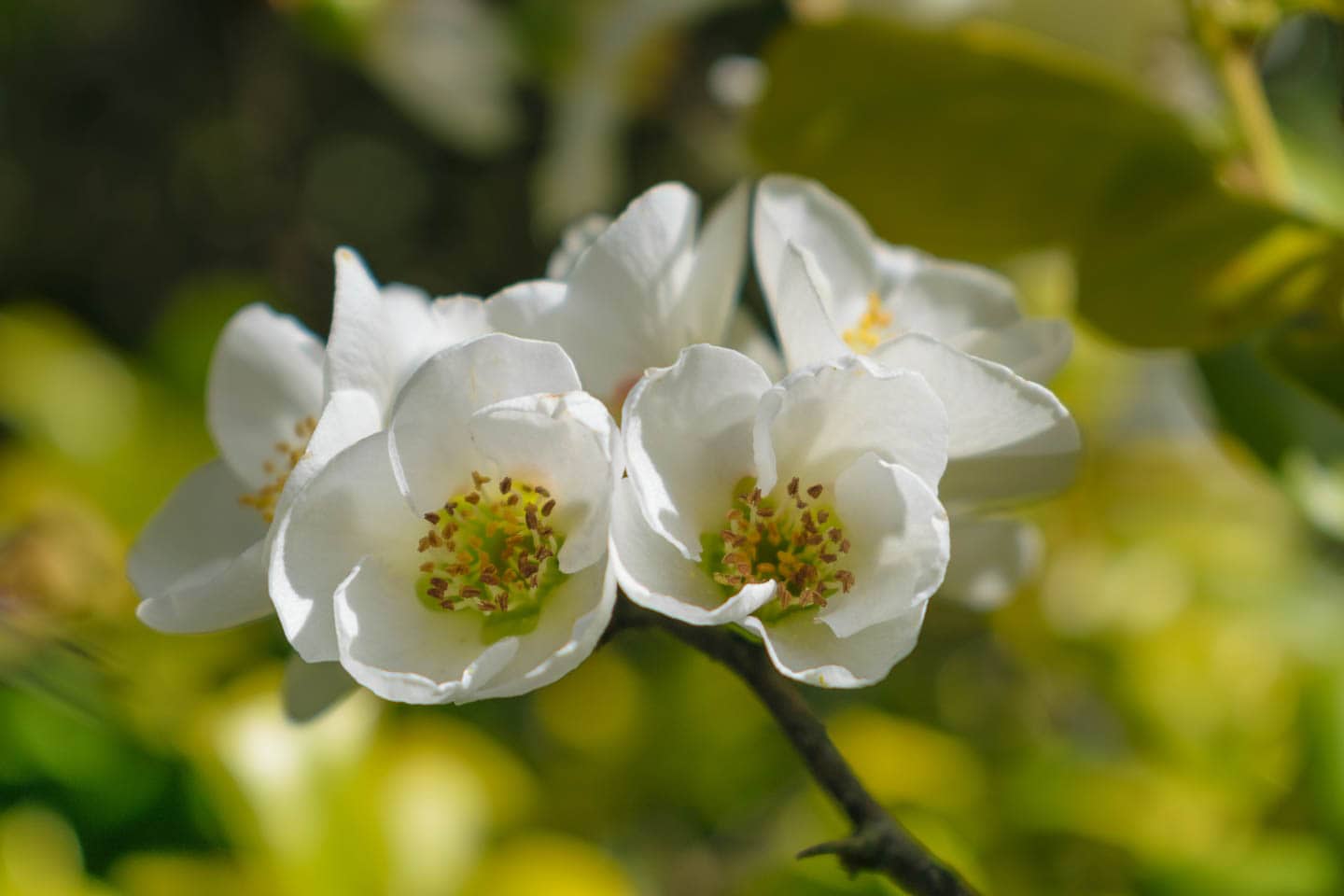
Scientific name: Chaenomeles speciosa ‘Nivalis’
Zone: 5 to 9
Exposure: sun, part shade
Height: 7′ to 8′
Width: 12′ to 13′
Bloom time: early spring
Bloom color: white
Lovely 1.5″ white fragrant blossoms cover this desirable deciduous shrub in early spring when little else is blooming. They give way to the development of sour greenish edible fruit that is used to make jams and jellies.
The thorny branches are deer and rabbit deterrents. Once established this tough shrub is also drought tolerant.
Good as a specimen or as a hedge, it looks amazing when espaliered against a wall. To reduce its spread, remove root suckers.
Varieties
- ‘Jet trails’ Quince is a smaller growing variety than ‘Nivalis” at 3′ to 5′ high and 3′ to 4’ wide.
- Chaenomeles ‘Contorta’ is 2′ to 3′ tall and wide. Can be grown as a bonsai.
20 | Star Magnolia
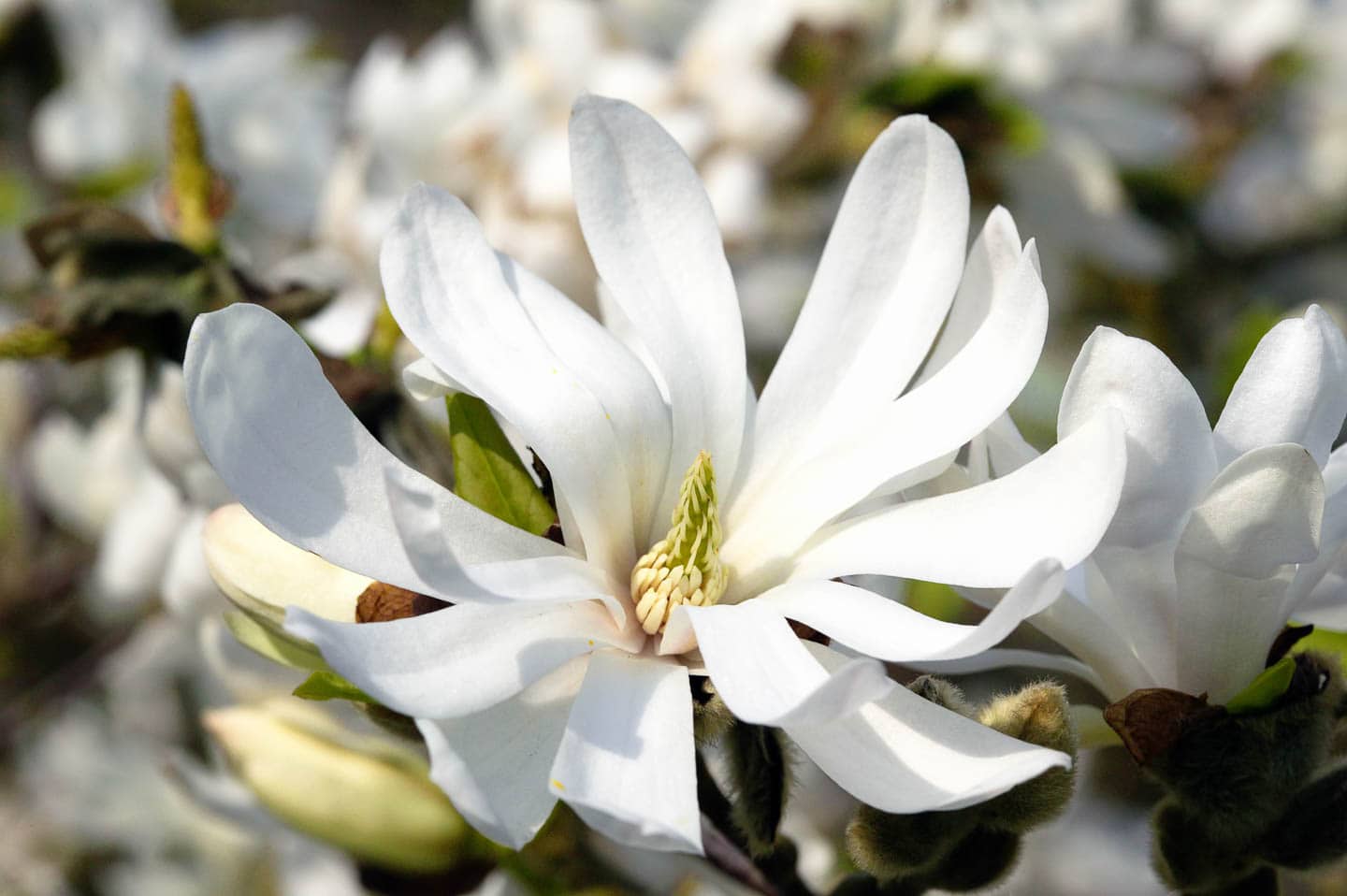
Scientific name: Magnolia stellata
Zone: 4 to 9
Exposure: sun, part sun
Height: 10′ to 15′
Width: 10′ to 12′
Bloom time: early spring
Bloom color: white or pink
The Star Magnolia, a native of Japan, is a glorious early spring sight when sporting its profusion of 4″, multi tepaled blooms on a rounded bush. The fragrant flowers appear before the elliptical leaves and act as magnets for bees and birds.
It likes average, well-drained soil, planted where it is sheltered from winds and early frost.
Varieties
- Magnolia stellata ‘Centennial Star’ — fragrant 5.5″ flowers on a large bush or small tree. A RHS award winner.
- Magnolia stellata ‘Royal Star’ — 6″ flowers burst from pink buds 10 days earlier than other star magnolias. A RHS award winner, it is a spectacular specimen plant.
21 | Japanese Camellia
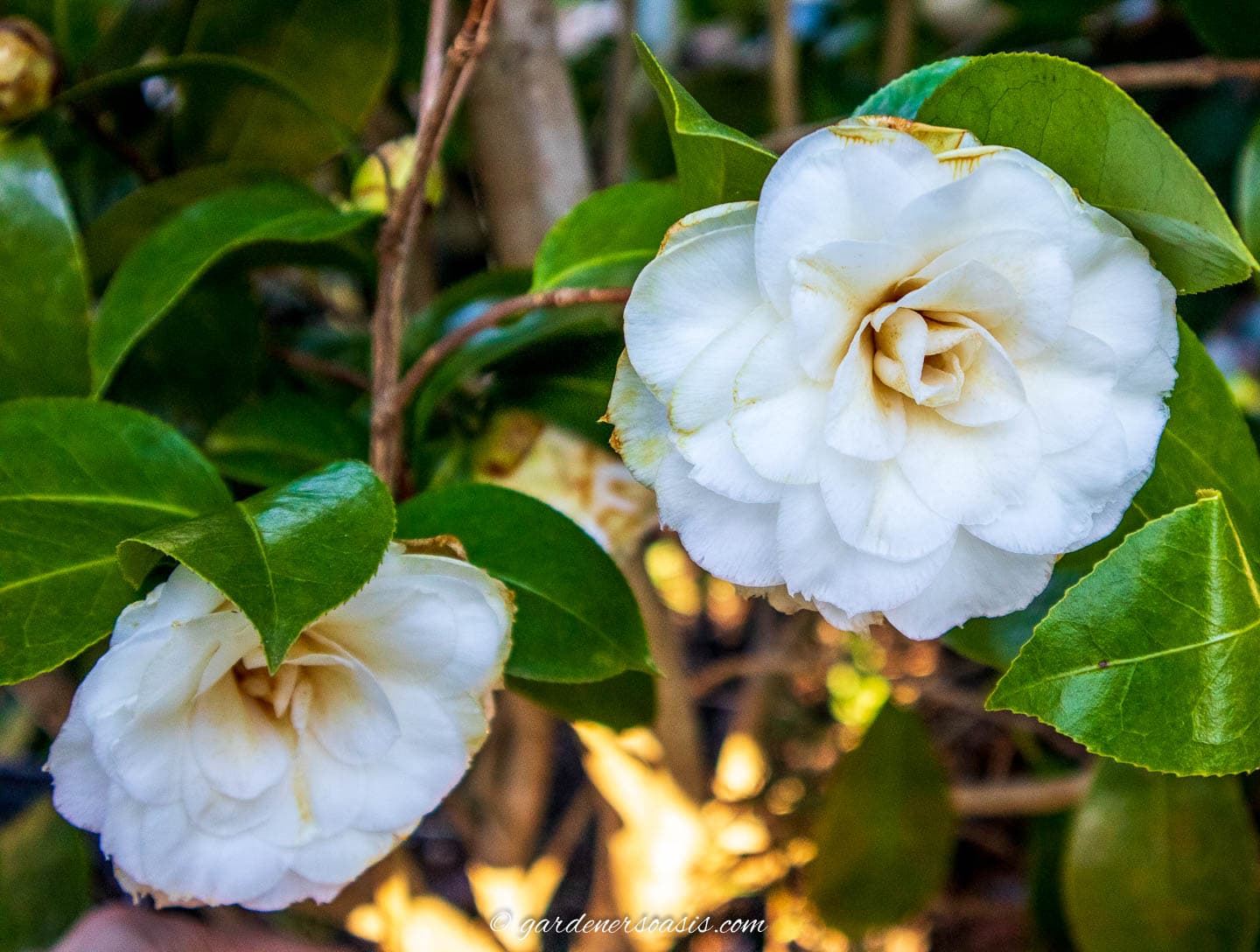
Scientific name: Camellia japonica
Zone: 7 to 9
Exposure: sun, part sun, shade
Height: 4′ to 10′ depending on the variety
Width: 3′ to 6′
Bloom time: early spring
Bloom color: white
Camellias have gorgeous, large, fragrant round petalled flowers on a glossy evergreen foliaged shrub that gardeners agree are one of the best.
They like acidic, well-drained, humus rich soil and do well in a shady location.
Their narrow habit makes them easy to place in the garden.
The taller varieties can be limbed up to turn them into small trees.
Be sure to cut some blossoms for a gorgeous, sweet smelling indoor bouquet!
Camelia are deer and drought tolerant (once established).
Varieties
- Camellia ‘Botanyuki’ — small double white peony shaped flowers. Grows 1 meter wide and tall. Good in containers.
- C. ‘Cinnamon Cindy’ — cinnamon scented, double white flowers from pink buds. A fast grower to 1.5 meters high. Good for a blooming hedge.
- C. japonica ‘Margaret Davies’ — a spectacular, large double flowering species with a 1.5 meter columnar habit.
- C. ‘Dahlonega’ — white with ruffled, double, pale yellow centers. This small (1meter by 70 cm) shrub looks good in small spaces or in containers.
- C. japonica ‘Nobilissima’ — very long blooming from November to March with large double blooms against evergreen foliage.
- C. japonica ‘Cinnamon Scentsation’ — blooms a little later than the above varieties on 1.5 meter light green bushes with aromatic, single flowers that have yellow stamens at the center.
- C. japonica ‘Alba Plena’ — an old reliable camillia that grows to 8′ and has large, double, white, unscented blooms.
22 | Daphne ‘Perfume Princess™ White’
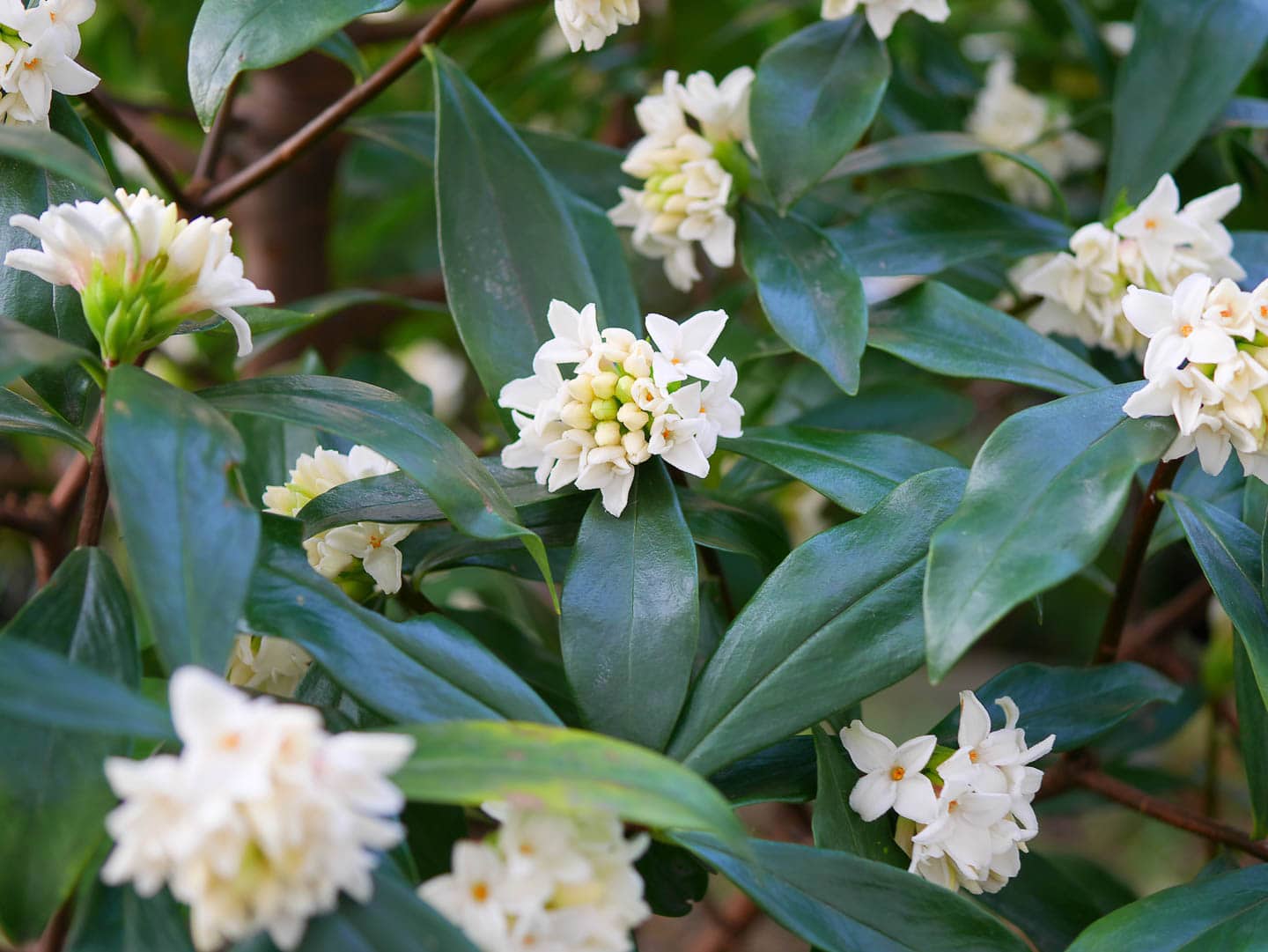
Scientific name: Daphne odoraxbholua ‘Perfume Princess™ White’
Zone: 7 to 9
Exposure: light shade
Height: 3′ to 4′
Width: 3′ to 4′
Bloom time: late winter to early spring
Bloom color: pink buds open to white flowers
With its beautiful flowers and beautiful perfume, winter daphne is a staple of the early spring garden.
And this variety is a prolific bloomer producing extra large clusters all along the branch, rather than just at the tips.
Plant this well rounded, evergreen shrub in evenly moist loamy soil, in part shade.
Its dainty white flowers will reward you by perfuming the whole early spring garden.
Daphne is resistant to deer.
Other early spring plants you might like
- Early spring white flowering trees
- Purple early spring flowers
- Blue early spring flowers
- Early spring yellow flowers
Have comments or questions about our white early spring flowers? Tell us in the section below.
This post was originally published on March 8, 2023 but was updated with new content on November 23, 2024.

